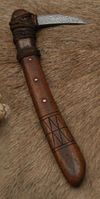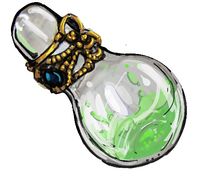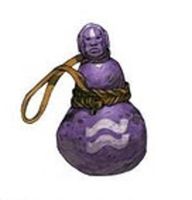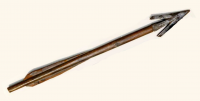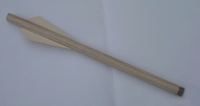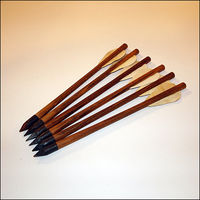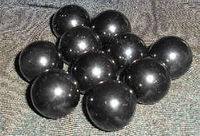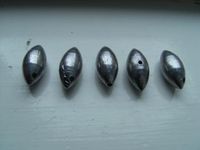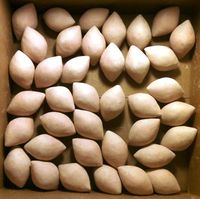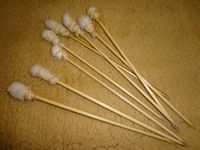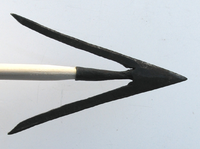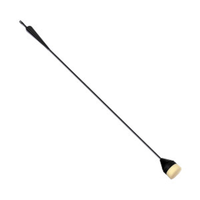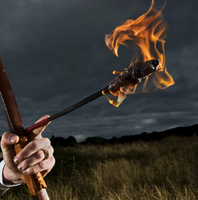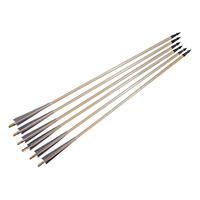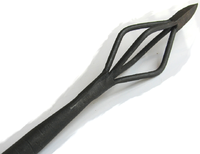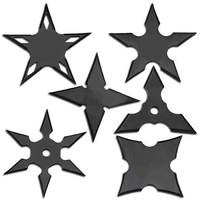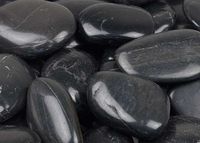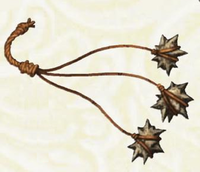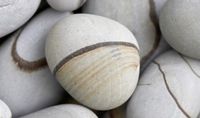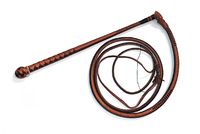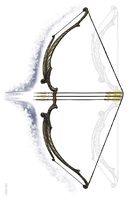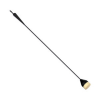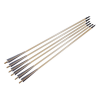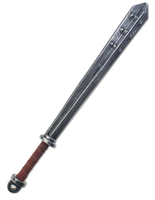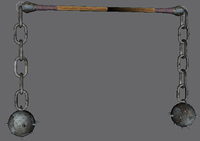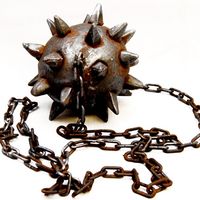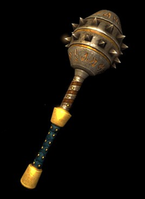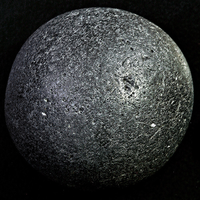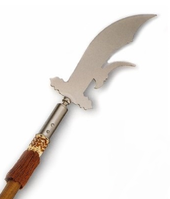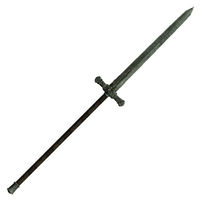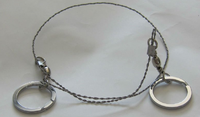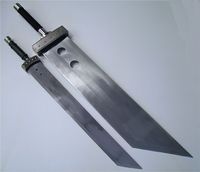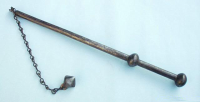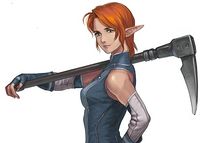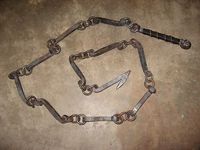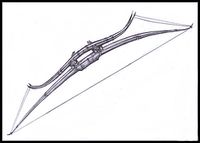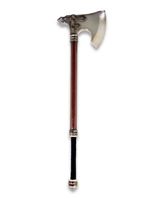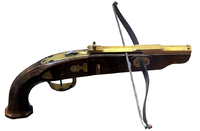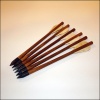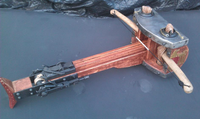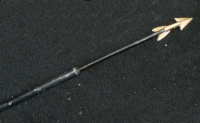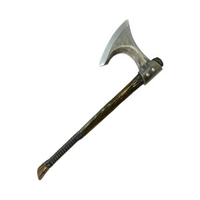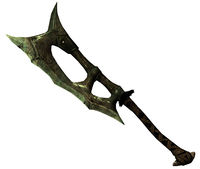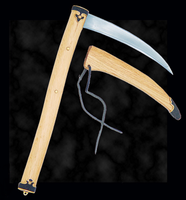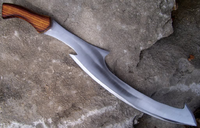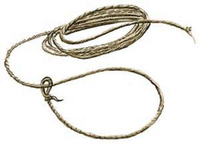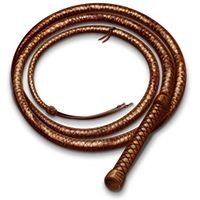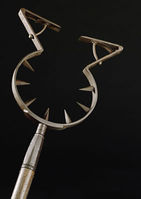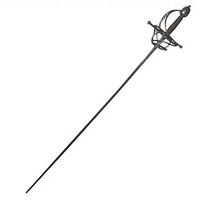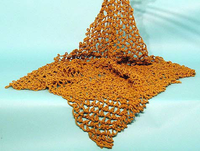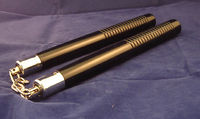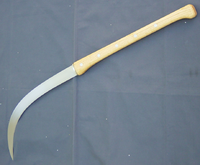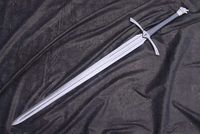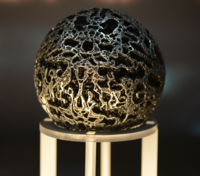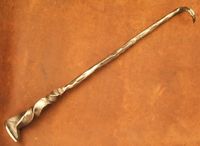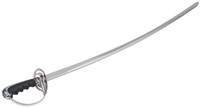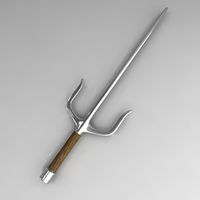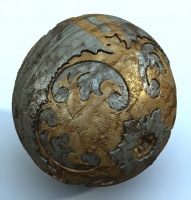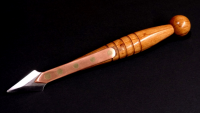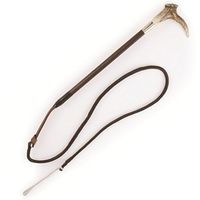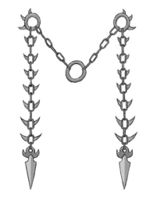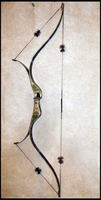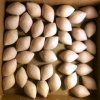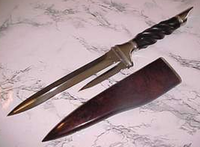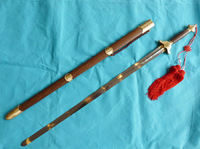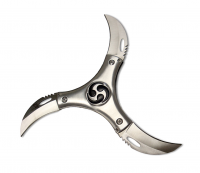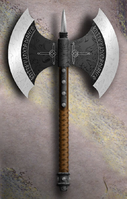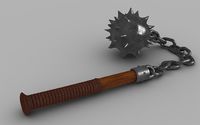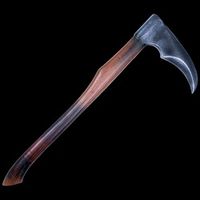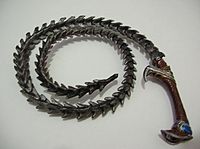Exotic Weapons
- Aklys (Weapon)
Aklys Light (1-Hand) / Exotic [edit] Cost Sm Dmg Med Dmg Large Dmg Crit Range Wt Type 20 gp 1d4 1d6 1d10 x2 20 ft.1 2 lbs Bludgeoning (physical, common) Weapon Qualities: Concealable, Fragile, Special, Trip The deceptively simple aklys looks like a curved stick with a hook on one end, tied to a five foot piece of strong cord. The Aklys is designed to do the maximum damage possible while still functioning as a light weapon, and as such its construction is not as durable as most weapons. In the hands of a specialist the humble aklys is deadly. When used with an exotic weapons proficiency, the aklys is counted as a light weapon, and can be thrown up to twenty feet. The string on the aklys is too short to tether it to the wielder. Instead, it can be thrown by a skilled user in such a way that the string wraps around the ankles and allows the wielder to perform a trip maneuver up to twenty feet away. Afterward, unless magic is employed, the aklys must be retrieved from the square upon which it was targeted and made ready for the next time it is needed. If the wielder does not have the exotic weapons proficiency, the Aklys may still be used in combat. In this case it is counted as a 1-handed martial melee weapon that does not have an entry in the range column. The Aklys belongs to the "Hammers" and "Thrown" weapon groups regardless of whether the wielder is skilled enough to throw it or not. - 1 This range is not an increment, it is the maximum distance the aklys may be thrown. This attack does not suffer range penalties.
- Ammunition
The composite versions of the shortbow, longbow, greatbow and stonebow use the same ammunition as their non-composite versions, and the damage and other characteristics of the ammunition for the composite versions are unchanged from their non-composite versions.
All costs and weights listed represent a single unit of the ammunition type described.
All items used as ammunition are considered to be expended upon use, either irreparably broken and damaged, or lost. You cannot retrieve ammunition for re-use.
Simple Ammunition
These types of ammunition require only a simple weapon proficiency to use proficiently.
Alchemical Bomb, Ammo
Simple/Ammo Cost Sm Dmg Med Dmg Large Dmg Crit Range Wt Type Alchemical Bomb, Sling (1) free! 1+bomb 1+bomb 1+bomb x2 30 ft 1/4th lb Bludgeoning (physical, common), plus bomb effect(s) Alchemical Bomb, Slingstaff (1) free! 2+bomb 2+bomb 2+bomb x2 40 ft 1/4th lb Bludgeoning, plus bomb effect(s) Alchemical Bomb, Stonebow (1) free! 3+bomb 3+bomb 3+bomb x2 50 ft 1/4th lb Bludgeoning, plus bomb effect(s) Weapon Qualities: Expendable Only Alchemists have access to this type of ammunition, but they are highly versatile. With the use of discoveries, alchemical bombs can be modified to do a huge variety of damage types, status conditions, and other nasty surprises for the unwary. Alchemical Creation, Ammo
Simple/Ammo Cost Sm Dmg Med Dmg Large Dmg Crit Range Wt Type Alchemical Creation, Sling (1) varies 1+effect 1+effect 1+effect x2 20 ft 1/4th lb Bludgeoning (physical, common), plus creation effect(s) Alchemical Creation, Slingstaff (1) varies 2+effect 2+effect 2+effect x2 30 ft 1/4th lb Bludgeoning, plus creation effect(s) Alchemical Creation, Stonebow (1) varies 3+effect 3+effect 3+effect x2 40 ft 1/4th lb Bludgeoning, plus creation effect(s) Weapon Qualities: Expendable Alchemical creations are items like alchemist's fire, tanglefoot bags, etc., a list of which can be found on the Alchemical Creations page. Bolt, Barbed
Simple/Ammo Cost Sm Dmg Med Dmg Large Dmg Crit Range Wt Type Barbed Bolt, Hand Crossbow 5 gp 1d4 1d6 1d10 19-20/x2 20 ft. 1/4th lb Piercing (physical, common) Barbed Bolt, Light Crossbow 5 gp 1d8 1d10 2d8 19-20/x2 40 ft. 1/4th lb Piercing Barbed Bolt, Heavy Crossbow 5 gp 1d10 1d12 3d6 19-20/x2 60 ft. 1/4th lb Piercing Barbed Bolt, Hand Onager 5 gp 2d8 2d10 4d8 19-20/x2 80 ft. 1/4th lb Piercing Weapon Qualities: Expendable Barbed crossbow bolts are just about the nastiest things you'll ever see. They are stout, brutal devices, whose wicked barbs make the terrible wounds already inflicted by a crossbow much, much worse. Unlike normal bolts, barbed bolts are difficult to make and thus are expensive. They are typically made of the same woods as arrows, although in a thick, strong, graceless fashion, and are often fletched with thin shavings of horn or turtle shell. The massive barbed heads require considerable skill to forge and sharpen. Barbed bolts are heavier than standard bolts, and cannot be fired as far as standard bolts. Pointing a crossbow loaded with a barbed bolt at a someone is a very clear statement that you mean business. Bolt, Blunt
Simple/Ammo Cost Sm Dmg Med Dmg Large Dmg Crit Range Wt Type Blunt Bolt, Hand Crossbow 5 cp 1d3 1d4 1d6 19-20/x2 15 ft. 1/10th lb Bludgeoning (physical, common) Blunt Bolt, Light Crossbow 5 cp 1d6 1d8 2d6 19-20/x2 40 ft. 1/10th lb Bludgeoning Blunt Bolt, Heavy Crossbow 5 cp 1d8 1d10 2d8 19-20/x2 60 ft. 1/10th lb Bludgeoning Blunt Bolt, Hand Onager 5 cp 2d6 2d8 3d8 19-20/x2 60 ft. 1/10th lb Bludgeoning Weapon Qualities: Expendable Blunt crossbow bolts have the simple conical tip of mild steel replaced by a small round bit of glued-on iron that covers the end of the thick wooden shaft. This means blunt bolts can be made without a blacksmith, just punched out bits of iron. As a result, the cost of blunt crossbow bolts is half that of standard bolts. Blunt bolts weigh the same and do the same amount of damage as regular bolts, although the range is halved. In a hand onager, blunt bolts grant the weapon the Sunder quality at range, since the Hand Onager is also a Siege Weapon. Bolt, Crossbow
Simple/Ammo Cost Sm Dmg Med Dmg Large Dmg Crit Range Wt Type Crossbow Bolt, Hand Crossbow 1 sp 1d3 1d4 1d6 19-20/x2 30 ft. 1/10th lb Piercing (physical, common) Crossbow Bolt, Light Crossbow 1 sp 1d6 1d8 2d6 19-20/x2 80 ft. 1/10th lb Piercing Crossbow Bolt, Heavy Crossbow 1 sp 1d8 1d10 2d8 19-20/x2 120 ft. 1/10th lb Piercing Crossbow Bolt, Hand Onager 1 sp 2d6 2d8 3d8 19-20/x2 120 ft. 1/10th lb Piercing Weapon Qualities: Expendable Crossbow bolts are thick, graceless things compared to arrows. In keeping with the simplicity of the crossbow, the bolts are not sophisticated, either. Arrows must be carefully made with just the right amount of flex, or spine, in the long, slim shafts. Bolts are far too thick and short to flex, even under the brutal firing conditions of heavy crossbows or hand onagers. Bolts have simple conical tips hammered of mild steel, massive shafts of heavy, cheap woods like greenheart, swamp oak, or sycamore, and durable fletching made of thin sections of cherry or pine. They take little to no skill to make, but they do have to be consistently made, so they are all the same size. Despite their low sophistication, nobody can argue that bolts lack in power, and they have won many, many battles.
Bolt, Poison
All weapons can be poisoned by a skilled poisoner. The poison bolt is the same as a regular crossbow bolt with poison on it.
Bolt, Fire
Crossbow bolt heads sit so close to the crossbow that a flaming bolt is a recipe for a ruined crossbow. This has been removed from the game. Flaming arrows (fired from bows) are still available.
Bullet, Dural
Simple/Ammo Cost Sm Dmg Med Dmg Large Dmg Crit Range Wt Type Dural Bullet, Sling 5 sp 1d6 1d8 2d6 19-20/x2 25 ft 3/4th lb Bludgeoning (physical, common) Dural Bullet, Slingstaff 5 sp 1d8 1d10 2d8 19-20/x2 40 ft 3/4th lb Bludgeoning Dural Bullet, Stonebow 5 sp 1d10 1d12 3d6 19-20/x2 50 ft 3/4th lb Bludgeoning Weapon Qualities: Expendable Dural is a rare type of stone mined far underground which is valuable for its extreme density and hardness. Dural is unsuited to most uses, it is brittle in thin cross-sections and easily cracks and flakes if it is shaped into flat surfaces. Most Dural is used in the form of sand, as an extremely potent abrasive in sandpaper. Some Dural is mined in large chunks and formed into spheres, which avoids the worst of its spalling property. In this form Dural can be used for ranged weapons and ammunition. Dural increases the cost of ammo by five times, raises the damage and critical chance considerably, lowers the range, and triples the weight of the ammo. Many well-heeled adventurers consider the expense and short range of Dural ammunition well worth the tradeoffs. Bullet, Groaning
Simple/Ammo Cost Sm Dmg Med Dmg Large Dmg Crit Range Wt Type Groaning Bullet, Sling 1 gp 1 1 1 x2 60 ft 1/10th lb Bludgeoning (physical, common) Groaning Bullet, Slingstaff 1 gp 1 1 1 x2 90 ft 1/10th lb Bludgeoning Groaning Bullet, Stonebow 1 gp 1 1 1 x2 150 ft 1/10th lb Bludgeoning Weapon Qualities: Audible, Expendable These sling bullets are riddled with cunning perforations that cause them to emit an eerie moan audible within 50 feet of their flight path. They are quite light and frangible, pulverizing into nearly harmless shards when they strike a target and inflicting only a single point of damage, although magic and strength can increase that considerably. Despite their light weight they are extremely aerodynamic and fly very far indeed. Bullet, Sling
Simple/Ammo Cost Sm Dmg Med Dmg Large Dmg Crit Range Wt Type Bullet, Sling 1 cp 1d4 1d6 1d8 x3 50 ft 1/4th lb Bludgeoning (physical, common) Bullet, Slingstaff 1 cp 1d6 1d8 2d6 x3 80 ft 1/4th lb Bludgeoning Bullet, Stonebow 1 cp 1d8 1d10 2d8 x3 100 ft 1/4th lb Bludgeoning Weapon Qualities: Expendable Sling bullets are dense, hard pellets with either a round or football shape to them. They can be made of metal, bone, stone, or even hard woods. They all weigh a quarter of a pound for the medium sized version of them. They are uniformly cheap, ten for a silver piece. Exotic sling bullets may be made of gemstones, teeth, or other things. Bullet, Smoke
Simple/Ammo Cost Sm Dmg Med Dmg Large Dmg Crit Range Wt Type Smoke Bullet, Sling 10 gp nil nil nil nil 30 ft 1/4th lb Bludgeoning (physical, common) Smoke Bullet, Slingstaff 10 gp nil nil nil nil 40 ft 1/4th lb Bludgeoning Smoke Bullet, Stonebow 10 gp nil nil nil nil 50 ft 1/4th lb Bludgeoning Weapon Qualities: Expendable, Special These fragile alchemical wonders are glass spheres full of a heavy clear fluid. When hurled, they require only a touch attack to strike a target and break harmlessly. They instantly form a three by three square area filled with smoke. This smoke offers concealment to anyone completely within it, or total concealment to anyone who is one square deep within it. The smoke lasts until the end of the encounter in still air(1 minute out of combat), or until the end of your next round in windy conditions. Gust of wind and stronger magics dispel it instantly. Dart, Blowgun
Simple/Ammo Cost Sm Dmg Med Dmg Large Dmg Crit Range Wt Type Dart, Blowgun 1 sp 1 1d2 1d3 x2 20 ft 1/20th lb Piercing (physical, common) Weapon Qualities: Expendable Usable only with a blowgun, these darts are most obviously used to deliver injury poisons, but they can also be an effective way to deliver extra damage from class abilities, such as a rogue's sneak attack, or a prowler's encroachment dice. Martial Ammunition
These ammunition types require a proficiency with at least one of the martial weapons which is capable of firing them.
Arrow, Common
Martial/Ammo Cost Sm Dmg Med Dmg Large Dmg Crit Range Wt Type Common Arrow, Shortbow 5 cp 1d4 1d6 1d10 x3 60 ft 1/10th lb Piercing (physical, common) Common Arrow, Longbow 5 cp 1d6 1d8 2d6 x3 100 ft 1/10th lb Piercing Common Arrow, Greatbow 5 cp 1d8 1d10 2d8 x3 120 ft 1/10th lb Piercing Weapon Qualities: Expendable Common arrows are standard bow ammunition. They have sturdy diamond points on them, they're shafted with easy to get ash, maple, or willow, and they have reliable goose-feather fletchings. They do a bit less damage in shortbows than they do in longbows, and a bit less damage in longbows than they do in greatbows. A common arrow is denoted by that classic, deadly but easy to make, diamond-shaped point. It's good against armor, it's good against beasts, and it can be made quickly. You'll see these everywhere, and rightly so, because they're great. Arrow, Barbed
Martial/Ammo Cost Sm Dmg Med Dmg Large Dmg Crit Range Wt Type Barbed Arrow, Shortbow 2 gp 1d3 1d4 1d6 x3 30 ft 1/2 lb Slashing (physical, common) Barbed Arrow, Longbow 2 gp 1d4 1d6 1d10 x3 50 ft 1/2 lb Slashing Barbed Arrow, Greatbow 2 gp 1d6 1d8 2d6 x3 60 ft 1/2 lb Slashing Weapon Qualities: Expendable, Special The barbed arrow is a specialty product, since making that extravagant head takes a lot of time and skill. Barbed arrows are based off broadhead arrows, with all their characteristics, but they do the same damage as flight arrows. So why bother with them? Because to remove a barbed arrowhead is a deadly and dangerous process. To remove a barbed arrow after you've been struck by one and taken damage past any DR requires greater than animal intelligence and a heal check against an Easy DC. Either the victim or an adjacent creature can attempt to remove barb heads. Failing the heal check means removing the barbed arrow inflicts 1d6 of additional damage which cannot be reduced by DR. Ouch. Arrow, Blunt
Martial/Ammo Cost Sm Dmg Med Dmg Large Dmg Crit Range Wt Type Blunt Arrow, Shortbow 5 sp 1d4 1d6 1d10 x3 30 ft 1/2 lb Bludgeoning (physical, common) Blunt Arrow, Longbow 5 sp 1d6 1d8 2d6 x3 50 ft 1/2 lb Bludgeoning Blunt Arrow, Greatbow 5 sp 1d8 1d10 2d8 x3 60 ft 1/2 lb Bludgeoning Weapon Qualities: Expendable, Special Take a broadhead arrow and remove that big, deadly steel point. Replace it with a shaped boiled-leather cup into which a tightly rolled mass of cotton cloth is firmly wedged, presenting the firm, flat side of the roll toward the front of the arrow. What you get is the blunt arrow, which does bludgeoning damage rather than piercing damage. Why would you do this? Well, hunting of some delicate game species is easier with blunt arrows. Blunt arrows have the same construction as broadhead arrows, but to keep that heavy, flat tip pointed right, they suffer a reduced range increment. Arrow, Broadhead
Martial/Ammo Cost Sm Dmg Med Dmg Large Dmg Crit Range Wt Type Broadhead Arrow, Shortbow 3 sp 1d6 1d8 2d6 x3 30 ft 1/4th lb Piercing (physical, common) Broadhead Arrow, Longbow 3 sp 1d8 1d10 2d8 x3 50 ft 1/4th lb Piercing Broadhead Arrow, Greatbow 3 sp 1d10 1d12 3d6 x3 60 ft 1/4th lb Piercing Weapon Qualities: Expendable The obvious difference to a broadhead arrow is the head, which is a heavy delta-shaped thing with sharp wings and modest barbs. They have more steel in them than common heads, and the blacksmith has to spend some time on them compared to diamond points. The shaft of the broadhead arrow is made of a dense, heavy wood like buckeye, hickory, or dogwood to maintain the proper spine with that heavy head on it. And instead of three fletchings a broadhead arrow has four, to keep that big-winged head pointed the right direction. As a result, broadheads are expensive, short-ranged, and weigh over twice as much as a standard arrow, but they hit really hard. Arrow, Flaming
Martial/Ammo Cost Sm Dmg Med Dmg Large Dmg Crit Range Wt Type Flaming arrow, Shortbow 3 gp 1d3 1d4 1d6 x3 30 ft 1/2 lb Piercing (physical, common) Flaming arrow, Longbow 3 gp 1d4 1d6 1d10 x3 50 ft 1/2 lb Piercing Flaming Arrow, Greatbow 3 gp 1d6 1d8 2d6 x3 60 ft 1/2 lb Piercing Weapon Qualities: Expendable, Special Flaming arrows are an age-old terror weapon. Flaming arrows are based off broadheads, as the dense, hardwood shafts are required to allow them to do their fiery work. The massive broadhead is removed and replaced with a small needle-like head with a hole in it. Through the hole is threaded a soft rag of cotton, wool, or linen and the whole thing is soaked in tar and wrapped around the head and top of the shaft. This is allowed to cool into a solid, flammable mass. Lighting a flaming arrow requires a move action and access to a considerable source of flame (larger than a torch, such as a good fire or a brazier). Any amount of magical flame will touch one off, as well. Once lit, a flaming arrow burns for 5 rounds, regardless of wind or rain, although being underwater or doused by a bucket will extinguish it. Flaming arrows do piercing damage as above, as well as 1d4 of fire damage to creatures struck. When fired at flammable structures like cloth wagon covers, thatch roofs, haystacks, etc, they ignite such things automatically the next round unless doused. On light wooden structures they ignite on a 1-2 on a d6 roll. On heavy wooden structures they ignite after three rounds on a roll of 1 on a d10. See the Environmental Effects rules for how to put things out again. Fire Arrows get really scary when you fire a few hundred of them at once.... Arrow, Flight
Martial/Ammo Cost Sm Dmg Med Dmg Large Dmg Crit Range Wt Type Flight Arrow, Shortbow 5 sp 1d3 1d4 1d6 x3 90 ft 1/20th lb Piercing (physical, common) Flight Arrow, Longbow 5 sp 1d4 1d6 1d10 x3 150 ft 1/20th lb Piercing Flight Arrow, Greatbow 5 sp 1d6 1d8 2d6 x3 160 ft 1/20th lb Piercing Weapon Qualities: Expendable Flight arrows are designed for the maximum possible range. As a result, they use common diamond-tip arrowheads in good quality steel but in very small sizes. The shafts are made of kiln-dried lightweight woods, like alder, fir, spruce, or cedar. And the fletching is small, often made of chicken feathers rather than goose. The result is an arrow that is the same size as a regular arrow but weighs about half as much and is ridiculously streamlined. Flight arrows shoot like lightning, and are what are used in target shooting competitions. Arrow, Whistling
Martial/Ammo Cost Sm Dmg Med Dmg Large Dmg Crit Range Wt Type Whistling arrow, Shortbow 1 gp 1d3 1d4 1d6 x3 60 ft 1/8th lb Piercing (physical, common) Whistling arrow, Longbow 1 gp 1d4 1d6 1d10 x3 100 ft 1/8th lb Piercing Whistling Arrow, Greatbow 1 gp 1d6 1d8 2d6 x3 120 ft 1/8th lb Piercing Weapon Qualities: Expendable, Audible Take a common arrow, replace that simple but elegant diamond point with a whistling cage made of bent rod, and you create a whistling arrow. These are audible in flight to a distance of 50 feet from the path of their flight, so they're pretty darn loud. They make a distinctive falling shriek as they fly that sounds eerie, especially if you get a few hundred going all at once. Great fun, but expensive. Whistling arrows even do reasonable damage, since they have a functional chisel point atop the whistling cage. Exotic Ammunition
Skiprocks require an exotic weapon proficiency in order to use their "Ricochet" ability. This is in addition to any other proficiency needed to wield one of the weapons capable of firing them. To fire skiprocks (with ricochet) from a stonebow requires two separate exotic weapon proficiency feats.
If used without this exotic weapon proficiency, they perform exactly like very expensive sling bullets.
Shuriken Light Thrown (1-Hand) / Exotic [edit] Cost Sm Dmg Med Dmg Large Dmg Crit Range Wt Type 2 sp 1d3 1d4 1d6 x2 20 ft 1/10th lbs Drilling (physical, uncommon) Weapon Qualities: Concealable, Monk-Usable, Non-Melee Shuriken are small discs or spikes of heavy, sharp steel or dweomermetal which are thrown at targets. An exotic weapon, Shuriken are usable by Monks, and any warrior who can master their odd behaviors. Despite their small size, the odd shape and extreme profile of the shuriken allows it to inflict amazing damage, and it is possible to hide them almost anywhere. A shuriken can't be used as a melee weapon. For purposes of Weapon Properties, Feats, and all other game play aspects, the Shuriken is treated as it it inflicts Piercing damage. The Shuriken belongs to the "Thrown" weapon group. Skiprock, Ammo
Exotic/Ammo Cost Sm Dmg Med Dmg Large Dmg Crit Range Wt Type Skiprock, Sling 3 gp 1d4 1d6 1d10 x2 20 ft 1/4th lb Bludgeoning (physical, common) Skiprock, Slingstaff 3 gp 1d6 1d8 2d6 x2 30 ft 1/4th lb Bludgeoning Skiprock, Stonebow 3 gp 1d8 1d10 2d8 x2 40 ft 1/4th lb Bludgeoning Weapon Qualities: Expendable* (see text), Non-Melee, Ricochet Skiprocks are like small puck-shaped rocks which can be thrown, used in a sling or fired from a stonebow. If used by someone with the Exotic Weapon Proficiency for skiprocks, they gain use of the ricochet ability, which can be used with any delivery method. Although skiprocks can be used as ammunition, they are thrown weapons for purposes of enchantment, drawing them for use, or for what happens to them after they are fired. Because of this, if a skiprock is enchanted to at least +1, it gains the Returning weapon property and retains that property even if fired from a projectile weapon with greater than a +1 enhancement. This means that a single skiprock can be used as ammunition multiple times per round if desired, as long as the returning property is able to function. When used as a thrown weapon, a skiprock is not usable in melee combat and so does not threaten and cannot be used for attacks of opportunity. Skiprock Ricochet Requires Exotic Weapon Proficiency: Skiprocks. Up to once per round, if you successfully strike your target, select a different foe within 10 feet of your first target and make a second attack. Resolve this second attack using the same attack bonuses and penalties as the first attack. On larger creatures you may choose the square you struck before determining the path to the second creature, though you must have line of effect to all squares in the path. Only roll damage once, but each target that was struck takes the full damage. Any precision damage included in the attack is only applied to the first target, but damage bonuses from Strength, feats, and magical bonuses are applied to both targets. Skiprocks belong to the "Thrown" weapon group. Ricochet may never be used more than once per round, regardless of how many attacks the throwing character has, how many different skiprocks they throw or how many different creatures they are targeting. - Bola (Weapon)
Bola 1-Hand Thrown / Exotic [edit] Cost Sm Dmg Med Dmg Large Dmg Crit Range Wt Type 15 gp 1d3 1d4 1d8 x2 10 ft 2 lbs Bludgeoning (physical, common) Weapon Qualities: Concealable, Non-Melee, Ranged Attack of Opportunity, Slow Draw, Trip The bola is a pair of short cords or light chains tied together in a criss-cross shape, with spiked weights tied to three of the four ends. A bola can be drawn and thrown with one hand. It always takes a move action to draw a bola, to avoid tangling the complex cordage, even with Quick Draw (Feat). When thrown by a proficient wielder, bolas spread out as they rotate and can wrap around a foe's legs. Despite their odd looks, bolas are extremely handy, and a proficient user can fling them at an instant's notice. Bolas cannot be used as a melee weapon. During the wielder's turn, bolas can be used to perform trip attacks. If the wielder of a bola is holding the weapon in their hand, they can use the bola to make an attack of opportunity against any foe who moves within thirty feet of them, even though it does not threaten in melee. However, when used to make any attack of opportunity, a bola cannot make a trip attack. A bola does not threaten, nor does it permit flanks. Bolas belong to the "Thrown" and "Flails" weapons groups. - Careen (Weapon)
Careen Light Thrown (1-Hand) / Exotic [edit] Cost Sm Dmg Med Dmg Large Dmg Crit Range Wt Type 30 gp 1d4 1d6 1d10 x2 20 ft 2 lbs Bludgeoning (physical, common) Weapon Qualities: Concealable, Deceptive, Non-Melee, Powerful, Strength-Based The careen, colloquially called "huckin' rocks", are one-handed spheres of dense stone a bit larger than a plum. They often have a somewhat oblong shape, and a distinct ridge upon which a finger may be placed for more control of their spin. Despite appearances, they are extremely deadly in the hands of an expert user, and can be hurled one-handed with incredible force and accuracy. Even more deadly, in the hands of a trained user, a careen weaves and turns in flight, making it extremely difficult to deflect, catching opponents off-guard, and even curving around shields. Careens allow the wielder to apply his Strength (instead of Dexterity) when calculating both to-hits and damage, as if it were a light melee weapon, though it cannot be used in melee. Indeed, a careen can even make use of Power Attack (Feat) as though it were a light melee weapon. Careens belong to the "Thrown" weapon group. - Cavalry Whip (Weapon)
Cavalry Whip 1-Hand / Exotic [edit] Cost Sm Dmg Med Dmg Large Dmg Crit Range Wt Type 30 gp 1d4 1d6 1d10 x2 - 6 lbs Slashing (physical, common) Weapon Qualities: Reach, Subduing, Unwieldy The Cavalry Whip is a Long Whip designed for mounted use. The Cavalry Whip has an enormous reach, allowing attack to squares both 15 feet (3 squares) and 20 feet (4 squares) away from the wielder. The Cavalry Whip cannot attack any squares within ten feet (2 squares, or adjacent) of the wielder, nor does it threaten within this range. If any adjacent square is blocked the wielder cannot use the weapon at all, and if any square within ten feet of the wielder is considered blocked you have -4 to hit when the weapon is used. A Cavalry Whip can be used afoot. This whip is identical to the Long whip except as above, and the handle is three feet long and the braid is "only" 14 feet long. The longer handle and shorter braid makes the weapon usable while mounted. The Cavalry Whip belongs to the "Flails", weapon group.
- Composite Greatbow (Weapon)
Composite Greatbow 2-Hand Projectile / Exotic [edit] Cost Sm Dmg Med Dmg Large Dmg Crit Range Wt Type 200 gp see ammo see ammo see ammo see ammo see ammo 6 lbs Piercing (physical, common) or by ammunition Weapon Qualities: Mighty, Non-Melee This is the composite version of the greatbow. Adjust cost per composite longbow, +200 gp per point of Strength mod applied to damage. For the purposes of any feats or abilities, the composite greatbow counts as a greatbow. The composite greatbow belongs to the "Bows" weapon group. Show / Hide Ammunition TypesAmmo Type Cost Sm Dmg Med Dmg Large Dmg Crit Range Wt Type Common Arrow 5 cp each 1d8 1d10 1d8 x3 120 ft 0.1 lbs each Piercing (physical, common) Weapon Qualities: Expendable Common arrows are standard bow ammunition. They have sturdy diamond points on them, they're shafted with easy to get ash, maple, or willow, and they have reliable goose-feather fletchings. They do a bit less damage in shortbows than they do in longbows, and a bit less damage in longbows than they do in greatbows. A common arrow is denoted by that classic, deadly but easy to make, diamond-shaped point. It's good against armor, it's good against beasts, and it can be made quickly. You'll see these everywhere, and rightly so, because they're great. Ammo Type Cost Sm Dmg Med Dmg Large Dmg Crit Range Wt Type Barbed Arrow 2 gp each 1d6 1d8 2d6 x3 60 ft 0.5 lbs each Slashing (physical, common) Weapon Qualities: Expendable, Weapon Qualities: Special The barbed arrow is a specialty product, since making that extravagant head takes a lot of time and skill. Barbed arrows are based off broadhead arrows, with all their characteristics, but they do the same damage as flight arrows. So why bother with them? Because to remove a barbed arrowhead is a deadly and dangerous process. To remove a barbed arrow after you've been struck by one and taken damage past any DR requires greater than animal intelligence and a heal check against an Easy DC. Either the victim or an adjacent creature can attempt to remove barb heads. Failing the heal check means removing the barbed arrow inflicts 1d6 of additional damage which cannot be reduced by DR. Ouch. Ammo Type Cost Sm Dmg Med Dmg Large Dmg Crit Range Wt Type Blunt Arrow 5 sp each 1d8 1d10 2d8 x3 60 ft 0.5 lbs each Bludgeoning (physical, common) Weapon Qualities: Expendable Take a broadhead arrow and remove that big, deadly steel point. Replace it with a shaped boiled-leather cup into which a tightly rolled mass of cotton cloth is firmly wedged, presenting the firm, flat side of the roll toward the front of the arrow. What you get is the blunt arrow, which does bludgeoning damage rather than piercing damage. Why would you do this? Well, hunting of some delicate game species is easier with blunt arrows. Blunt arrows have the same construction as broadhead arrows, but to keep that heavy, flat tip pointed right, they suffer a reduced range increment. Ammo Type Cost Sm Dmg Med Dmg Large Dmg Crit Range Wt Type Broadhead Arrow 3 sp each 1d10 1d12 3d6 x3 60 ft 0.25 lbs each Piercing (physical, common) Weapon Qualities: Expendable The obvious difference to a broadhead arrow is the head, which is a heavy delta-shaped thing with sharp wings and modest barbs. They have more steel in them than common heads, and the blacksmith has to spend some time on them compared to diamond points. The shaft of the broadhead arrow is made of a dense, heavy wood like buckeye, hickory, or dogwood to maintain the proper spine with that heavy head on it. And instead of three fletchings a broadhead arrow has four, to keep that big-winged head pointed the right direction. As a result, broadheads are expensive, short-ranged, and weigh over twice as much as a standard arrow, but they hit really hard. Ammo Type Cost Sm Dmg Med Dmg Large Dmg Crit Range Wt Type Flaming Arrow 3 gp each 1d6 1d8 2d6 x3 60 ft 0.5 lbs each Piercing (physical, common) Weapon Qualities: Expendable, Special Flaming arrows are an age-old terror weapon. Flaming arrows are based off broadheads, as the dense, hardwood shafts are required to allow them to do their fiery work. The massive broadhead is removed and replaced with a small needle-like head with a hole in it. Through the hole is threaded a soft rag of cotton, wool, or linen and the whole thing is soaked in tar and wrapped around the head and top of the shaft. This is allowed to cool into a solid, flammable mass. Lighting a flaming arrow requires a move action and access to a considerable source of flame (larger than a torch, such as a good fire or a brazier). Any amount of magical flame will touch one off, as well. Once lit, a flaming arrow burns for 5 rounds, regardless of wind or rain, although being underwater or doused by a bucket will extinguish it. Flaming arrows do piercing damage as above, as well as 1d4 of fire damage to creatures struck. When fired at flammable structures like cloth wagon covers, thatch roofs, haystacks, etc, they ignite such things automatically the next round unless doused. On light wooden structures they ignite on a 1-2 on a d6 roll. On heavy wooden structures they ignite after three rounds on a roll of 1 on a d10. See the Environmental Effects rules for how to put things out again. Fire Arrows get really scary when you fire a few hundred of them at once.... Ammo Type Cost Sm Dmg Med Dmg Large Dmg Crit Range Wt Type Flight Arrow 5 sp each 1d6 1d8 2d6 x3 160 ft 0.05 lbs each Piercing (physical, common) Weapon Qualities: Expendable Flight arrows are designed for the maximum possible range. As a result, they use common diamond-tip arrowheads in good quality steel but in very small sizes. The shafts are made of kiln-dried lightweight woods, like alder, fir, spruce, or cedar. And the fletching is small, often made of chicken feathers rather than goose. The result is an arrow that is the same size as a regular arrow but weighs about half as much and is ridiculously streamlined. Flight arrows shoot like lightning, and are what are used in target shooting competitions. Ammo Type Cost Sm Dmg Med Dmg Large Dmg Crit Range Wt Type Whistling Arrow 1 gp each 1d6 1d8 2d6 x3 120 ft 0.1 lbs each Piercing (physical, common) Weapon Qualities: Expendable, Audible Take a common arrow, replace that simple but elegant diamond point with a whistling cage made of bent rod, and you create a whistling arrow. These are audible in flight to a distance of 50 feet from the path of their flight, so they're pretty darn loud. They make a distinctive falling shriek as they fly that sounds eerie, especially if you get a few hundred going all at once. Great fun, but expensive. Whistling arrows even do reasonable damage, since they have a functional chisel point atop the whistling cage. - Cruciate Mace (Weapon)
Cruciate Mace 1-Hand / Exotic [edit] Cost Sm Dmg Med Dmg Large Dmg Crit Range Wt Type 20 gp 1d8 1d10 2d8 x2 - 8 lbs Bludgeoning (physical, common) or Piercing (physical, common) Weapon Qualities: Brutal A cruciate mace is made of solid metal (or similar substance) which through the blacksmith's art has been forged in an "X" cross section keeping it light enough (barely) to be wielded in one hand. The business end is liberally equipped with jagged sawteeth which allow the weapon to inflict piercing as well as bludgeoning damage with a slight twist of the wrist. Sadly, the small teeth make it unlikely a cruciate mace will do exceptional damage, but it certainly hits hard. The cruciate mace belongs to the "Hammers", weapon group. - Cruciate Maul (Weapon)
Cruciate Maul 2-Hand / Exotic [edit] Cost Sm Dmg Med Dmg Large Dmg Crit Range Wt Type 30 gp 1d10 1d12 3d6 19-20 x2 - 15 lbs Bludgeoning (physical, common) or Piercing (physical, common) Weapon Qualities: Brutal The cruciate maul is a solid metal (or similar material) bludgeoning weapon of tremendous weight and size. It is forged into an "X" cross section keeping it barely light enough to wield. The business end is liberally equipped with small saw teeth so the damage type can be either piercing or bludgeoning, at the discretion of the user. The small teeth mean that the weapon does some extra damage on a critical, and the weight and narrow aspect of the weapon allow it to deal significant damage consistently. The unusual shape and balance of the cruciate maul make it an exotic weapon. The cruciate maul belongs to the "Blades, Light" and "Hammers" weapon groups. - Dire Flail (Weapon)
Dire Flail 2-Hand / Exotic [edit] Cost Sm Dmg Med Dmg Large Dmg Crit Range Wt Type 90 gp 1d6/1d6 1d8/1d8 2d6/2d6 x2 - 10 lbs Buffeting (physical, uncommon) Weapon Qualities: Disarm, Double, Trip A dire flail is a terrifying thing to witness in action in the hands of a skilled user. But in the hands of an unskilled user, it's comedy gold. Using a dire flail is an art, and the sheer number of attacks and the unpredictability of it all makes the dire flail much more dangerous than it seems like it should be. The dire flail belongs to the "Double" and "Flails" weapon groups, and is treated as a bludgeoning weapon for the application of Weapon Properties, Feats, Dweomermetals and all other effects. - Dorn Dergar (Weapon)
Dorn Dergar 2-Hand / Exotic [edit] Cost Sm Dmg Med Dmg Large Dmg Crit Range Wt Type 50 gp 1d8 1d10 2d8 x3 - 15 lbs Bludgeoning (physical, common) Weapon Qualities: Adaptive Reach, Intimidating, Stout, Trip This exotic weapon is a 10-foot-long, heavy metal chain weighted at the end by a round ball of solid iron about the size of a large fist. Though fallen into disuse over the spanning centuries, the dwarven dorn dergar is still sometimes employed by dwarves who cling to the old ways. Despite its current rarity, the dorn dergar is a capable weapon if you have the skill to use it to its potential. The dorn dergar belongs to the "Flails" weapon group. - Dread Maul (Weapon)
Dread Maul 2-Hand / Exotic [edit] Cost Sm Dmg Med Dmg Large Dmg Crit Range Wt Type 80 gp 2d6 2d8 3d8 x3 - 35 lbs Bludgeoning (physical, common) Weapon Qualities: Handy, Massive, Stout While the cruciate weapons are marvels of the weapon-makers art, the dread maul is a paragon of simplicity. Take a mass of metal the size of a small child, attach a sturdy stick to it, and then smash things with it. Despite the simplicity of the design, the dread maul requires a minimum Strength score of 18 and an exotic weapon proficiency to wield effectively. It is said that any fool can swing a dread maul, but it can take a lifetime to learn to use it well. The dread maul belongs to the "Hammers", weapon group. - Dural Shotput (Weapon)
Dural Shotput 2-Hand Thrown / Exotic [edit] Cost Sm Dmg Med Dmg Large Dmg Crit Range Wt Type 75 gp 1d12 2d8 3d8 19-20 x2 10 ft 36 lbs Bludgeoning (physical, common) Weapon Qualities: Massive, Ponderous, Poor Melee, Powerful, Strength-Based Identical to the shotput, except that it is made from the magical stone, dural, which is an extremely dense material that is nearly impossible to shape into anything complex, but just fine at simple shapes like a spherical shotput. Dural shotputs have a much shorter range than a traditional shotput, though they are more likely to inflict a severe wound. They are massive weapons, requiring a minimum of 18 strength to wield proficiently. Like shotputs, dural shotputs belong to the "Thrown" weapons group.
- Dwarven Urgrosh (Weapon)
Dwarven Urgrosh 2-Hand / Exotic [edit] Cost Sm Dmg Med Dmg Large Dmg Crit Range Wt Type 50 gp 1d6/1d4 1d8/1d6 2d6/1d10 x3 - 12 lbs Spindling (physical, rare) or Hacking (physical, uncommon) Weapon Qualities: Battering, Brace, Double, Intimidating, Stout A dwarven urgrosh is a double weapon, but unlike a double sword, using an urgrosh is not a graceful balletic dance. An urgrosh is a long battle axe with a nasty spear point on the opposite end of the long haft. The urgrosh's axe head is a Hacking weapon while its spear head is a Spindling weapon. You can use either head as the primary weapon. The other becomes the off-hand weapon. If you brace an urgrosh against a charging character, the spear head (Spindling) is the part of the weapon that deals damage. In typical use by a skilled user, swipes by the axe head alternate with vicious stabs by the spear, usually into the tops of the feet. An urgrosh isn't pretty, but it works excellently. The dwarven urgrosh belongs to the "Double" weapon group. The axe head is treated as a slashing weapon, while the spear head is treated as a piercing weapon, for the application of Weapon Properties, Feats, Dweomermetals and all other effects. - Falcata (Weapon)
Falcata 1-Hand / Exotic [edit] Cost Sm Dmg Med Dmg Large Dmg Crit Range Wt Type 18 gp 1d6 1d8 2d6 17-20 x2 - 4 lbs Hacking (physical, uncommon) Weapon Qualities: The falcata is an odd-looking thing, with that droopy nose and massive hooked hilt. In the hands of a skilled user, the design is shown to be a marvel of deadly intent. It is every bit as good as a longsword in cut-and-thrust combat, but the curved edge, forward balance, and aggressive point combine to inflict extremely severe wounds when a well-aimed strike drives home. The Falcata belongs to the "Blades, Heavy" weapon group, and is treated as a slashing weapon for the application of Weapon Properties, Feats, Dweomermetals and all other effects. - Fauchard (Weapon)
Fauchard 2-Hand / Exotic [edit] Cost Sm Dmg Med Dmg Large Dmg Crit Range Wt Type 44 gp 1d8 1d10 2d8 18-20 x2 - 10 lbs Slashing (physical, common) Weapon Qualities: Adaptive Reach, Brace, Disarm, Dismounting, Trip Among polearms, the fauchard (also known as 'the devil's fork') is the hardest one to use well. In the hands of a user without an exotic weapons proficiency, a fauchard will be next to useless. But once you learn how to wield it, it is deadly. A fauchard is similar to a glaive in that it grants 10 feet of reach, allowing attacks at 2 squares distance from the wielder, and it can be switched to close attacks as well. In addition, the back-hook has been turned into a forward facing prong, creating a 'fork' effect on the back of the weapon. To a skilled user, that fork enables both disarming attempts and trip maneuvers. A fauchard is better made than most pole arms, with good steel and selected wooden parts so it can be swung faster and harder than most pole arms. A fauchard does good damage and is much more maneuverable than you would expect, since a twist of the wrists can present either of the two tips for an attack. As a result it is much easier to score a dangerous strike with a fauchard than you might expect. The fauchard belongs to the "Polearms" weapon group. - Flambard (Weapon)
Flambard 2-Hand / Exotic [edit] Cost Sm Dmg Med Dmg Large Dmg Crit Range Wt Type 100 gp 1d10 3d4 5d4 19-20 x2 - 9 lbs Slashing (physical, common) Weapon Qualities: Battering, Stout, Sunder, Hewing The flambard is a great sword with a special wavy blade. You can't use the tip of a flambard very well, but it is tremendously efficient at sundering objects, due to the strength of the wavy blade. The flambard belongs to the "Blades, Heavy" weapon group. - Flickerspike (Weapon)
Flickerspike 2-Hand / Exotic [edit] Cost Sm Dmg Med Dmg Large Dmg Crit Range Wt Type 150 gp 1d6 1d8 2d6 18-20 x2 - 4 lbs Spindling (physical, rare) Weapon Qualities: Adaptive Reach, Blocking, Finesse The flickerspike, sometimes called the four-handed sword or the doubled-hilted sword, is the needlesword's much larger and deadlier cousin. The flickerspike has a blade about the same size as a bastard sword but has a very long, light hilt, usually at least twenty inches long, to provide increased leverage to the blade. The flickerspike is a masterpiece of the swordmaker's art, a two-handed weapon of unsurpassed lightness and speed. A flickerspike is so light and finely made, it can even be used with Weapon Finesse (Feat). Due to the extreme length of the flickerspike, it can be used to attack foes ten feet away with a swift action by adjusting your grip. When used this way, the flickerspike threatens squares ten feet away, but does not threaten adjacent squares. Another swift action can be used to return to the regular grip, losing the reach but threatening adjacent squares. If used while fighting defensively, the flickerspike's length, leverage, and speed adds a +1 shield bonus to AC during the maneuver. A flickerspike does not do huge amounts of damage for a two-handed weapon, but it makes up for this with many dangerous critical attacks. The unusual size, weight, and balance of the flickerspike makes it an exotic weapon. The flickerspike belongs to the "Blades, Light" and "Polearms" weapon groups, and is treated as a piercing weapon for the application of Weapon Properties, Feats, Dweomermetals and all other effects. - Garrote (Weapon)
Garrote 2-Hand / Exotic [edit] Cost Sm Dmg Med Dmg Large Dmg Crit Range Wt Type 20 gp 1d10 1d10 1d10 x2 - 1/2 lb Slashing (physical, common) Weapon Qualities: Grapple, Special, Unaware A garrote is a vicious weapon that requires a clear shot at a vulnerable point. In order for you to use a garrote, your opponent must be helpless or unaware of you. You must make a grapple check (though you do not suffer the -4 penalty for not having two hands free) to successfully begin garroting your opponent. Despite being a two-handed weapon (and granting 1.5 times your Str to its damage) the garrote is treated as a light weapon and may be used to make attacks during a grapple. Precision damage may not be added to a garrote's damage (though Rogues still do half their sneak attack damage, because they cheat). Enemies with concealment may still be targeted with a garrote attack. Each round you control the grapple, instead of the damage action, you choke your opponent, cutting off your target's air supply (inflicting the Gagging condition). Each round after the first that you successfully maintain the grapple, you may escalate this condition one step up the array (to Choking, and then to Asphyxiating in the third round). Any round you do not maintain the choke, your opponent can take a breath and the Gagging, Choking, or Asphyxiating condition immediately ends. If you lose control of a grapple while using a garrote, the garrote is considered broken and may not be used again until repaired.
Your garroted opponent must make a Caster Check versus a DC equal to your Maneuver Defense to cast a spell with a verbal component, use a command word item, or use any ability requiring speech. A garroted opponent may not make any sound with his mouth, assuming the garrote is around the neck.
Creatures immune to criticals, precision damage or creatures not required to breathe may still speak, cast spells and cannot be choked out, though they still take damage from your attacks.
The garrote is not a member of any weapon group.
- Godsword (Weapon)
Godsword 2-Hand / Exotic [edit] Cost Sm Dmg Med Dmg Large Dmg Crit Range Wt Type 100 gp 2d6 2d8 3d8 19-20 x2 - 21 lbs Slashing (physical, common) Weapon Qualities: Handy, Massive Massive, sturdy, over six feet long and re-enforced for its entire length, the godsword is the ultimate embodiment of power that the swordsmith can create. The largest of the two-handed swords by a good margin, the godsword is not about refinement. Somebody using a godsword is not interested in subtlety, finesse, or negotiations. Using a godsword is as much a declaration of philosophy as a weapon choice. The godsword has the massive quality, requires a minimum Strength score of 18 and an exotic weapon proficiency to wield effectively. The godsword belongs to the "Blades, Heavy" weapon group. - Great Flail (Weapon)
Great Flail 2-Hand / Exotic [edit] Cost Sm Dmg Med Dmg Large Dmg Crit Range Wt Type 70 gp 1d10 2d6 3d6 19-20 x2 - 15 lbs Bludgeoning (physical, common) Weapon Qualities: Battering, Disarm, Intimidating, Trip A great flail is a specialist's weapon, and that specialty is to completely overwhelm every foe they face. A great flail isn't pretty, nor the subject of fanciful tales like the big swords are. But a great flail makes up for it with tremendous battlefield utility, such as plucking weapons from a foe's hands, wrapping around a wrist or ankle to toss a foe to the ground, and of course, hitting like the angry fist of a god. A great flail offers no defensive qualities, but simply having one is likely to make canny foes avoid you on the battlefield, so that's something. The great flail belongs to the "Flails" weapon groups. - Great Pick (Weapon)
Great Pick 2-Hand / Exotic [edit] Cost Sm Dmg Med Dmg Large Dmg Crit Range Wt Type 40 gp 1d8 1d10 2d8 19-20 x4 - 9 lbs Spindling (physical, rare) Weapon Qualities: Battering, Pilfering, Sunder, Trip The great pick is a heavy two-handed weapon, whose rarity and extremely top-heavy balance make it an exotic weapon. The damage it does is not large for a two-handed weapon, but with every swing it has the chance to do massive critical damage on a lucky strike. The great pick belongs to the "Axes" and "Blades, Heavy" weapon groups, and is treated as a piercing weapon for the application of Weapon Properties, Feats, Dweomermetals and all other effects. - Great Whip (Weapon)
Great Whip 2-Hand / Exotic [edit] Cost Sm Dmg Med Dmg Large Dmg Crit Range Wt Type 125 gp 1d10 2d6 3d6 19-20 x2 - 12 lbs Slashing (physical, common) Weapon Qualities: Cumbersome, Reach The great whip deals lethal damage and has a 15-foot reach, threatening and allowing attack both 15 feet (3 squares) and 10 feet (2 squares) from the wielder, although it does not threaten and cannot attack adjacent targets. A great whip takes considerable space to wield freely, if any adjacent square is blocked, the user suffers a -4 penalty to attack rolls. The largest and by far the most dangerous of the whips, the mighty great whip has a sturdy handle three feet long, with a complex woven leather and wire braid as thick as a strong man's wrist attached to it. The braid is usually nine feet long, and has a sharp blade tip as well as secondary blades woven into the leather and wire braid for the last five or six feet. The great whip is surprisingly wieldy for its size, and a skilled user can use the enormous reach and power to devastating effect. A great whip takes quite a bit of space to use effectively, but much less than many would assume, given its size. The great whip belongs to the "Blades, Heavy" and "Flails" weapon groups.
- Greatbow (Weapon)
Greatbow 2-Hand Projectile / Exotic [edit] Cost Sm Dmg Med Dmg Large Dmg Crit Range Wt Type 150 gp 1d8 1d10 2d8 x3 120 ft 6 lbs Piercing or by ammunition Weapon Qualities: Non-Melee The greatbow is a rare but extremely powerful weapon. Also called a double bow or war bow, the greatbow is physically not much larger than a longbow. However, because of the exotic double-limbed design, the greatbow has a much heavier draw weight and a considerably longer draw than a longbow of equal size, while the limb speed is considerably higher, since thinner, more responsive limbs can be used. Since a greatbow must be drawn back further than a longbow (usually to the point of the jaw or even further), it requires an exotic weapon proficiency to use properly. The greatbow belongs to the "Bows" weapon group. Show / Hide Ammunition TypesAmmo Type Cost Sm Dmg Med Dmg Large Dmg Crit Range Wt Type Common Arrow 5 cp each 1d8 1d10 1d8 x3 120 ft 0.1 lbs each Piercing (physical, common) Weapon Qualities: Expendable Common arrows are standard bow ammunition. They have sturdy diamond points on them, they're shafted with easy to get ash, maple, or willow, and they have reliable goose-feather fletchings. They do a bit less damage in shortbows than they do in longbows, and a bit less damage in longbows than they do in greatbows. A common arrow is denoted by that classic, deadly but easy to make, diamond-shaped point. It's good against armor, it's good against beasts, and it can be made quickly. You'll see these everywhere, and rightly so, because they're great. Ammo Type Cost Sm Dmg Med Dmg Large Dmg Crit Range Wt Type Barbed Arrow 2 gp each 1d6 1d8 2d6 x3 60 ft 0.5 lbs each Slashing (physical, common) Weapon Qualities: Expendable, Weapon Qualities: Special The barbed arrow is a specialty product, since making that extravagant head takes a lot of time and skill. Barbed arrows are based off broadhead arrows, with all their characteristics, but they do the same damage as flight arrows. So why bother with them? Because to remove a barbed arrowhead is a deadly and dangerous process. To remove a barbed arrow after you've been struck by one and taken damage past any DR requires greater than animal intelligence and a heal check against an Easy DC. Either the victim or an adjacent creature can attempt to remove barb heads. Failing the heal check means removing the barbed arrow inflicts 1d6 of additional damage which cannot be reduced by DR. Ouch. Ammo Type Cost Sm Dmg Med Dmg Large Dmg Crit Range Wt Type Blunt Arrow 5 sp each 1d8 1d10 2d8 x3 60 ft 0.5 lbs each Bludgeoning (physical, common) Weapon Qualities: Expendable Take a broadhead arrow and remove that big, deadly steel point. Replace it with a shaped boiled-leather cup into which a tightly rolled mass of cotton cloth is firmly wedged, presenting the firm, flat side of the roll toward the front of the arrow. What you get is the blunt arrow, which does bludgeoning damage rather than piercing damage. Why would you do this? Well, hunting of some delicate game species is easier with blunt arrows. Blunt arrows have the same construction as broadhead arrows, but to keep that heavy, flat tip pointed right, they suffer a reduced range increment. Ammo Type Cost Sm Dmg Med Dmg Large Dmg Crit Range Wt Type Broadhead Arrow 3 sp each 1d10 1d12 3d6 x3 60 ft 0.25 lbs each Piercing (physical, common) Weapon Qualities: Expendable The obvious difference to a broadhead arrow is the head, which is a heavy delta-shaped thing with sharp wings and modest barbs. They have more steel in them than common heads, and the blacksmith has to spend some time on them compared to diamond points. The shaft of the broadhead arrow is made of a dense, heavy wood like buckeye, hickory, or dogwood to maintain the proper spine with that heavy head on it. And instead of three fletchings a broadhead arrow has four, to keep that big-winged head pointed the right direction. As a result, broadheads are expensive, short-ranged, and weigh over twice as much as a standard arrow, but they hit really hard. Ammo Type Cost Sm Dmg Med Dmg Large Dmg Crit Range Wt Type Flaming Arrow 3 gp each 1d6 1d8 2d6 x3 60 ft 0.5 lbs each Piercing (physical, common) Weapon Qualities: Expendable, Special Flaming arrows are an age-old terror weapon. Flaming arrows are based off broadheads, as the dense, hardwood shafts are required to allow them to do their fiery work. The massive broadhead is removed and replaced with a small needle-like head with a hole in it. Through the hole is threaded a soft rag of cotton, wool, or linen and the whole thing is soaked in tar and wrapped around the head and top of the shaft. This is allowed to cool into a solid, flammable mass. Lighting a flaming arrow requires a move action and access to a considerable source of flame (larger than a torch, such as a good fire or a brazier). Any amount of magical flame will touch one off, as well. Once lit, a flaming arrow burns for 5 rounds, regardless of wind or rain, although being underwater or doused by a bucket will extinguish it. Flaming arrows do piercing damage as above, as well as 1d4 of fire damage to creatures struck. When fired at flammable structures like cloth wagon covers, thatch roofs, haystacks, etc, they ignite such things automatically the next round unless doused. On light wooden structures they ignite on a 1-2 on a d6 roll. On heavy wooden structures they ignite after three rounds on a roll of 1 on a d10. See the Environmental Effects rules for how to put things out again. Fire Arrows get really scary when you fire a few hundred of them at once.... Ammo Type Cost Sm Dmg Med Dmg Large Dmg Crit Range Wt Type Flight Arrow 5 sp each 1d6 1d8 2d6 x3 160 ft 0.05 lbs each Piercing (physical, common) Weapon Qualities: Expendable Flight arrows are designed for the maximum possible range. As a result, they use common diamond-tip arrowheads in good quality steel but in very small sizes. The shafts are made of kiln-dried lightweight woods, like alder, fir, spruce, or cedar. And the fletching is small, often made of chicken feathers rather than goose. The result is an arrow that is the same size as a regular arrow but weighs about half as much and is ridiculously streamlined. Flight arrows shoot like lightning, and are what are used in target shooting competitions. Ammo Type Cost Sm Dmg Med Dmg Large Dmg Crit Range Wt Type Whistling Arrow 1 gp each 1d6 1d8 2d6 x3 120 ft 0.1 lbs each Piercing (physical, common) Weapon Qualities: Expendable, Audible Take a common arrow, replace that simple but elegant diamond point with a whistling cage made of bent rod, and you create a whistling arrow. These are audible in flight to a distance of 50 feet from the path of their flight, so they're pretty darn loud. They make a distinctive falling shriek as they fly that sounds eerie, especially if you get a few hundred going all at once. Great fun, but expensive. Whistling arrows even do reasonable damage, since they have a functional chisel point atop the whistling cage. - Hafted War Axe (Weapon)
Hafted War Axe 2-Hand / Exotic [edit] Cost Sm Dmg Med Dmg Large Dmg Crit Range Wt Type 80 gp 1d10 1d12 3d6 x3 - 12 lbs Slashing (physical, common) or Piercing (physical, common) Weapon Qualities: Adaptive Reach, Sunder The hafted war axe has a square chopping axe blade on one side and a sturdy beak on the other, enabling the wielder to choose between slashing and piercing damage with each swing. In addition, the beak is sturdy enough to use as a pry bar, granting the wielder a bonus when making sunder attempts. Last, the hafted war axe uses an overlong handle made of lightweight, magically-treated wood. With a swift action, the wielder may shift his grip to use the weapon as if it has a reach of ten feet, and while being used this way the hafted war axe threatens squares ten feet away but does not threaten adjacent squares. The wielder may return to the regular (non-reach) grip with another swift action. The hafted war axe belongs to the "Axe", "Blades, Heavy" and "Polearms" weapon groups. - Hand Crossbow (Weapon)
Hand Crossbow Light Projectile / Exotic [edit] Cost Sm Dmg Med Dmg Large Dmg Crit Range Wt Type 100 gp see ammo see ammo see ammo see ammo see ammo 2 lbs Piercing (physical, common) or by ammunition Weapon Qualities: Mighty, Non-Melee A hand crossbow is a very small crossbow, typically intended to be fired early in a combat and discarded, to be retrieved and loaded after the fight ends. They are favored by drow as a means of delivering poisons. You can draw back the action of a hand crossbow by hand. You can shoot, but not load, a hand crossbow with one hand at no penalty. You can shoot a hand crossbow with each hand, but you take a penalty on attack rolls as if attacking with two light weapons. Hand crossbows can be purchased in higher draw weights to match the Strength bonus of the wielder. This costs 25 gp per Strength mod plus added. Load: Loading a hand crossbow can be performed with either a move action or an attack action. The reload time can be reduced by taking the Rapid Reload (Feat).
The hand crossbow belongs to the "Crossbows" weapon group.
Show / Hide Ammunition TypesAmmo Type Cost Sm Dmg Med Dmg Large Dmg Crit Range Wt Type Crossbow Bolt 1 sp each 1d3 1d4 1d8 19-20 / x2 30 ft 0.1 lbs each Piercing (physical, common) Weapon Qualities: Expendable Crossbow bolts are thick, graceless things compared to arrows. In keeping with the simplicity of the crossbow, the bolts are not sophisticated, either. Arrows must be carefully made with just the right amount of flex, or spine, in the long, slim shafts. Bolts are far too thick and short to flex, even under the brutal firing conditions of heavy crossbows or hand onagers. Bolts have simple conical tips hammered of mild steel, massive shafts of heavy, cheap woods like greenheart, swamp oak, or sycamore, and durable fletching made of thin sections of cherry or pine. They take little to no skill to make, but they do have to be consistently made, so they are all the same size. Despite their low sophistication, nobody can argue that bolts lack in power, and they have won many, many battles. Ammo Type Cost Sm Dmg Med Dmg Large Dmg Crit Range Wt Type Barbed Bolt 5 gp each 1d4 1d6 1d10 19-20 / x2 20 ft 0.25 lbs each Piercing (physical, common) Weapon Qualities: Expendable Barbed crossbow bolts are just about the nastiest things you'll ever see. They are stout, brutal devices, whose wicked barbs make the terrible wounds already inflicted by a crossbow much, much worse. Unlike normal bolts, barbed bolts are difficult to make and thus are expensive. They are typically made of the same woods as arrows, although in a thick, strong, graceless fashion, and are often fletched with thin shavings of horn or turtle shell. The massive barbed heads require considerable skill to forge and sharpen. Barbed bolts are heavier than standard bolts, and cannot be fired as far as standard bolts. Pointing a crossbow loaded with a barbed bolt at a someone is a very clear statement that you mean business. Ammo Type Cost Sm Dmg Med Dmg Large Dmg Crit Range Wt Type Blunt Bolt 5 cp each 1d3 1d4 1d8 19-20 / x2 15 ft 0.1 lbs each Bludgeoning (physical, common) Weapon Qualities: Expendable Blunt crossbow bolts have the simple conical tip of mild steel replaced by a small round bit of glued-on iron that covers the end of the thick wooden shaft. This means blunt bolts can be made without a blacksmith, just punched out bits of iron. As a result, the cost of blunt crossbow bolts is half that of standard bolts. Blunt bolts weigh the same and do the same amount of damage as regular bolts, although the range is halved. In a hand onager, blunt bolts grant the weapon the Sunder quality at range, since the Hand Onager is also a Siege Weapon. - Hand Onager (Weapon)
Hand Onager 2-Hand Projectile / Exotic [edit] Cost Sm Dmg Med Dmg Large Dmg Crit Range Wt Type 250 gp see ammo see ammo see ammo see ammo see ammo 18 lbs Piercing (physical, common) or by ammunition Weapon Qualities: Handy, Massive, Mighty, Non-Melee The hand onager is a powerful ranged weapon rarely seen in use. A hand onager uses twisted skeins of spider silk to place tension upon a pair of sturdy wooden arms. It is treated as a heavy crossbow and a siege weapon to determine what feats are usable with it. Unlike lesser crossbow-class weapons, a hand onager may never be fired one-handed under any circumstances. A hand onager fires the same ammo a heavy crossbow fires, but with significantly greater force. A large part of this is due to the fact that a hand onager does not keep the bowstring under tension when it is not cocked, so it can be made with much heavier draw weights without worrying about breaking the string. Even more important, for a given size, a hand onager can be drawn back much further than a crossbow, and the longer length of draw allows it to shoot much harder even at the same draw weight. In addition, a hand onager can be obtained in Mighty versions at a price of 250gp per Strength plus. Load: Cranking back the arms of a hand onager to reload can be performed with either a move action or an attack action. The reload time can be reduced by taking the Rapid Reload (Feat).
The hand onager belongs to the "Crossbows" and "Siege Engines" weapon groups
Show / Hide Ammunition TypesAmmo Type Cost Sm Dmg Med Dmg Large Dmg Crit Range Wt Type Crossbow Bolt 1 sp each 2d6 2d8 3d8 19-20 / x2 120 ft 0.1 lbs each Piercing (physical, common) Weapon Qualities: Expendable Crossbow bolts are thick, graceless things compared to arrows. In keeping with the simplicity of the crossbow, the bolts are not sophisticated, either. Arrows must be carefully made with just the right amount of flex, or spine, in the long, slim shafts. Bolts are far too thick and short to flex, even under the brutal firing conditions of heavy crossbows or hand onagers. Bolts have simple conical tips hammered of mild steel, massive shafts of heavy, cheap woods like greenheart, swamp oak, or sycamore, and durable fletching made of thin sections of cherry or pine. They take little to no skill to make, but they do have to be consistently made, so they are all the same size. Despite their low sophistication, nobody can argue that bolts lack in power, and they have won many, many battles. Ammo Type Cost Sm Dmg Med Dmg Large Dmg Crit Range Wt Type Barbed Bolt 5 gp each 2d8 2d10 4d8 19-20 / x2 80 ft 0.25 lbs each Piercing (physical, common) Weapon Qualities: Expendable Barbed crossbow bolts are just about the nastiest things you'll ever see. They are stout, brutal devices, whose wicked barbs make the terrible wounds already inflicted by a crossbow much, much worse. Unlike normal bolts, barbed bolts are difficult to make and thus are expensive. They are typically made of the same woods as arrows, although in a thick, strong, graceless fashion, and are often fletched with thin shavings of horn or turtle shell. The massive barbed heads require considerable skill to forge and sharpen. Barbed bolts are heavier than standard bolts, and cannot be fired as far as standard bolts. Pointing a crossbow loaded with a barbed bolt at a someone is a very clear statement that you mean business. Ammo Type Cost Sm Dmg Med Dmg Large Dmg Crit Range Wt Type Blunt Bolt 5 cp each 2d6 2d8 3d8 19-20 / x2 60 ft 0.1 lbs each Bludgeoning (physical, common) Weapon Qualities: Expendable Blunt crossbow bolts have the simple conical tip of mild steel replaced by a small round bit of glued-on iron that covers the end of the thick wooden shaft. This means blunt bolts can be made without a blacksmith, just punched out bits of iron. As a result, the cost of blunt crossbow bolts is half that of standard bolts. Blunt bolts weigh the same and do the same amount of damage as regular bolts, although the range is halved. In a hand onager, blunt bolts grant the weapon the Sunder quality at range, since the Hand Onager is also a Siege Weapon. - Harpoon (Weapon)
Harpoon 2-Hand / Exotic [edit] Cost Sm Dmg Med Dmg Large Dmg Crit Range Wt Type 25 gp 1d4 1d6 1d10 x2 20 ft 30 lbs Spindling (physical, rare) Weapon Qualities: Entangling, Forced Bleed, Melee Capable, Retrieving, Special A harpoon is a two-handed melee weapon, and may be used as such with no hint at its nasty secrets. The harpoon's true cruelty arises when it is hurled in combat. A harpoon is a nasty, barbed spear with one hundred feet of hemp rope attached. As such, its maximum range is 100 feet. The weight listed includes the weight of the rope. If you use a harpoon without the rope, reduce the weight by twenty pounds, you lose the use of the retrieving quality, and you may throw the harpoon further than one hundred feet if you have abilities or feats that increase your maximum range bands. Note you may purchase a harpoon with 100 feet of Spider Silk rope instead of hemp. This increases the price by 200 gold pieces, but lowers the weight to 14 pounds. Once the retrieving quality is used in combat, the rope becomes hopelessly tangled and must be un-knotted, and coiled in a specific way. This process requires 5 minutes of preparation, before the retrieving quality of the harpoon may be used again. It is also quite common for the rope to be cut, requiring a fresh rope be installed (a similar 5-minute process).
Any attack which inflicts damage to the foe (hits their AC and overcomes any DR) means the harpoon has stuck to the foe. The enemy gains the Entangled condition. Even worse, the harpoon inflicts a Bleed condition, dealing 1 point of damage per round, which cannot be ended unless the harpoon is removed first. To remove a harpoon requires higher than animal intelligence and takes a standard action by either the creature struck or another creature adjacent to the creature struck. Removing a harpoon ends the Entangled condition and allows a heal check or healing to end the Bleed condition as well.
Note that the Harpoon's ability to inflict the Entangled quality and enable the Retrieving quality are mundane qualities that pierce the immunity to conditions conveyed by some monster roles (such as heavies and threats).
As long as a creature is Entangled by a harpoon with a rope attached, the wielder of that harpoon may expend a move action to retrieve the Entangled foe. Retrieving is a type of Reposition maneuver, requiring an opposed Might roll against the victim's Maneuver Defense. If successful, you may move a harpooned foe only into squares closer to you than the square the foe started in.
The Harpoon belongs to the "Spears" and "Thrown" weapon groups, and is treated as a piercing weapon for the application of Weapon Properties, Feats, Dweomermetals and all other effects.
- Hooked Axe (Weapon)
Hooked Axe 1-Hand / Exotic [edit] Cost Sm Dmg Med Dmg Large Dmg Crit Range Wt Type 20 gp 1d6 1d8 2d6 x3 - 7 lbs Hacking (physical, uncommon) Weapon Qualities: Disarm, Pilfering, Trip Like many exotic weapons, the hooked axe looks deceptively simple. It's just a battleaxe with a funny blade, right? Indeed, a character with martial weapons skill can use a hooked axe just fine, and it acts exactly as a battleaxe when so used. In the hands of a skilled user, however, the hooked axe is revealed as a grappling hook of deadly ability. The hooked axe can catch a wrist to disarm a foe, or catch an ankle to trip, and it looks darn good doing it, too. The Hooked Axe belongs to the "Axes" weapon group, and is treated as a slashing weapon for the application of Weapon Properties, Feats, Dweomermetals and all other effects. - Imperial Axe (Weapon)
Imperial Axe 2-Hand / Exotic [edit] Cost Sm Dmg Med Dmg Large Dmg Crit Range Wt Type 75 gp 2d6 2d8 3d8 x3 - 30 lbs Slashing (physical, common) Weapon Qualities: Handy, Intimidating, Massive The imperial axe features an axe head roughly twice as large as a greataxe, and the haft only adds another two feet to the length. The extreme size and unusual balance of the imperial axe make it an exotic weapon, requiring an exotic weapon proficiency to use. The imperial axe is designed for close-in bloodwork, and as a result, is so unwieldy out of combat that using an imperial axe is a testament to the owner's approach to combat. Namely, they like it. Approach with care. The imperial axe belongs to the "Axes" and "Blades, Heavy" weapon groups. - Kama (Weapon)
Kama Light (1-Hand) / Exotic [edit] Cost Sm Dmg Med Dmg Large Dmg Crit Range Wt Type 2 gp 1d4 1d6 1d10 x2 - 2 lbs Slashing (physical, common) Weapon Qualities: Monk-Usable, Stout, Trip A kama is a sturdy stick with a strong slicing blade mounted at a ninety degree angle at one end. They may be used by monks in their blinding fast attacks, and any skilled wielder can use the hooked shape to improve their trip maneuvers. The Kama belongs to the "Blades, Light" and "Monk" weapon groups. - Khopesh (Weapon)
Khopesh 1-Hand / Exotic [edit] Cost Sm Dmg Med Dmg Large Dmg Crit Range Wt Type 20 gp 1d6 1d8 2d6 18-20 x2 - 8 lbs Slashing (physical, common) Weapon Qualities: Trip, Pilfering If the falcata is odd, the khopesh is downright weird, with that odd bowl shaped blade and the little jags and barbs all over the blade. And it weighs a ton! But in the hands of a skilled user, the subtle design is clear: The khopesh is at least as effective in cut-and-thrust as a longsword, but it is designed to hook and catch on your opponents armor and clothing at all engagement ranges and hurl him to the ground. A foe on the ground is soon a dead foe, as all serious warriors know. The Khopesh belongs to the "Blades, Heavy" weapon group. - Lasso (Weapon)
Lasso 2-Hand Thrown / Exotic [edit] Cost Sm Dmg Med Dmg Large Dmg Crit Range Wt Type 10 gp - - - - 10 ft 5 lbs N/A Weapon Qualities: Entangling, Non-Melee, Retrieving, Touch The lasso is not a rope, even though it is made from a rope. A lasso is carefully formed and shaped from rope soaked in paraffin, so it holds its shape but can still perform its function. A typical lasso is fifty feet long, and so cannot be thrown more than fifty feet. Attacking with a lasso requires both hands, inflicts no damage, and is a ranged touch attack. If the touch attack is successful, the lasso inflicts the Entangled condition on the victim. Note that the lasso's ability to inflict the Entangled quality and enable the Retrieving quality are mundane qualities that pierce the immunity to conditions conveyed by some monster roles (such as heavies and threats).
The wielder can expend a move action to place tension on the lasso. As long as the attacker is maintaining tension every round by expending a move action, the victim may not escape the lasso. The victim (or one of the victim's allies) may attack the lasso if they have a slashing weapon, using the Sunder combat maneuver. If the attacker drops the lasso or fails to use a move action to maintain tension on the rope, the victim may escape the lasso by expending a move action. Each round that the wielder is maintaining tension on the lasso, he may roll a Might skill roll with a +2 weapon bonus against the victim's Maneuver Defense to pull the victim closer to him as part of the same move action as maintaining tension.
Assuming the lasso is not entangling a target and has not been sundered, or if the ranged touch attack misses the target, it requires a standard action to coil the lasso back into a configuration suitable for throwing again.
The lasso belongs to the "Thrown" weapons group.
- Long Whip (Weapon)
Long Whip 1-Hand / Exotic [edit] Cost Sm Dmg Med Dmg Large Dmg Crit Range Wt Type 20 gp 1d4 1d6 1d10 x2 - 5 lbs Slashing (physical, common) Weapon Qualities: Reach, Trip, Unwieldy The Long Whip has an enormous reach, allowing attacks at 20 feet (4 squares), 15 feet (3 squares) and 10 feet (2 squares) from the wielder, but cannot attack adjacent squares, nor does it threaten within this range. The long whip can be used to perform trips. It is not usable with the Weapon Finesse feat. A Long Whip takes a great deal of space to use skillfully. If any adjacent square is considered blocked you cannot use the weapon, and if any square within ten feet of the wielder is considered blocked you have -4 to hit when the weapon is used. A Long Whip cannot be used while mounted. This weapon is similar to a Heavy Whip, but much longer. The Long Whip has enormous reach, and in the hands of a strong and skilled user can tip the tide of most battles. A Long Whip has a handle about a foot long, but the braid is much thinner than most whips and about 16 feet long, with a wire-reinforced tip. The Long Whip belongs to the "Flails" weapon group.
- Mancatcher (Weapon)
Mancatcher 2-Hand / Exotic [edit] Cost Sm Dmg Med Dmg Large Dmg Crit Range Wt Type 15 gp 1d4 1d6 1d10 x2 - 10 lbs Piercing (physical, common) Weapon Qualities: Grapple, Reach, Size-Specific, Subduing, Special A mancatcher has ten feet (2 squares) of reach, allowing attacks at ten feet but it does not threaten and cannot attack adjacent targets. A mancatcher is built to capture a creature of a particular size category (such as Small or Medium) and doesn't work at all on creatures of the wrong size. Make a touch attack to hit an opponent and a Might skill check to grapple him (without the -4 penalty for not having two hands free); success means you and the target are grappled. Once the target is grappled, you can perform a move or damage grapple action against him. Note that a mancatcher cannot do damage until a grapple is successfully initiated and only while the wielder retains control of the grapple. While grappling, the mancatcher is treated as a light weapon and thus may be used in a grapple to do damage. At all other times, the mancatcher follows the rules of a two-handed weapon. The mancatcher can be Broken with a successful Sunder maneuver, immediately ending any grapple it is currently controlling and preventing it from being used to make new grapples until it is repaired. If you drop the mancatcher, the target can free himself as a standard action. If the target wins the grapple and frees himself, the mancatcher is not damaged. If the foe attempts to win control of the grapple and grapple the user of the mancatcher, the user may drop the mancatcher to end the grapple.
Multiple people using mancatchers can gang up on the same grappled victim, increasing the effective Might or Maneuver Offense roll of the first grappler by +4 per additional mancatcher. The Mancatcher belongs to the "Polearms" weapon group.
- Needlesword (Weapon)
Needlesword 1-Hand / Exotic [edit] Cost Sm Dmg Med Dmg Large Dmg Crit Range Wt Type 100 gp 1d4 1d6 1d10 18-20 x2 - 2 lbs Piercing (physical, common) Weapon Qualities: Deceptive, Distracting, Finesse, One-Handed Only The Needlesword is the pinnacle of the swordmakers art, the largest yet lightest blade a master weaponsmith with magical skills and tools can produce. A Needlesword is a needle-slender weapon with a guard made of a tracery of thin wire and the barest wisp of leather padding on the thin handle. A Needlesword does no more damage than a rapier, but in the hands of a skilled wielder (using an Exotic Weapon Proficiency) it can do serious damage on a critical strike. The Needlesword's light weight allows Dexterity to be used for attacks, and can even enhance the effect of feints. The Needlesword is favored as a weapon by many nobles for whom a rapier is too "common". A Needlesword cannot be wielded in two hands for extra damage, but it can be used with the Weapon Finesse feat. The Needlesword belongs to the "Blades, Light" weapon group, even though it is large enough that it is actually a one-handed weapon. - Net (Weapon)
Net 2-Hand Thrown / Exotic [edit] Cost Sm Dmg Med Dmg Large Dmg Crit Range Wt Type 20 gp - - - - 10 ft 12 lbs N/A Weapon Qualities: Non-Melee, Pinning, Slow Draw, Touch A combat net is made of heavy jute, which is loosely knotted together to make the strands slip and slide across one another. This makes the net hard to maintain, but makes it very soft and able to conform to objects despite its very sturdy weave. The loose weave also means that it always takes a move action to draw a Net for use, even if you have Quick Draw (Feat). When a net is thrown it deals no damage. Attacking with a net requires both hands. When it is hurled by a skilled user it spreads in the air and wraps around a foe as long as they are within one size category larger or smaller than the wielder. Attacking with a net is a ranged touch attack, and upon a successful hit, the net inflicts the Pinned condition. To remove the pinned condition, the victim must expend a full round action to unwrap and throw off the net with an Escape Artist check versus the attacker's Maneuver Defense. This is the only action which the pinned creature can undertake while pinned by a net. If they make this roll by 5 or more, it takes only a move action to escape the net. A net which has been thrown at a target must be gathered and carefully folded back into a throwable shape, requiring a full minute before it can be thrown again.
Note that a net's ability to inflict the Pinned condition does NOT pierce the immunity to conditions conveyed by some monster roles (such as heavies and threats).
The net belongs to the "Thrown" weapons group.
- Nunchaku (Weapon)
Nunchaku Light (1-Hand) / Exotic [edit] Cost Sm Dmg Med Dmg Large Dmg Crit Range Wt Type 2 gp 1d4 1d6 1d10 x2 - 3 lbs Buffeting (physical, uncommon) Weapon Qualities: Concealable, Disarm, Hard-Hitting, Monk-Usable Nunchaku are a pair of light, symmetrical clubs joined by a short segment of chain, creating a kind of flail that is designed for extremely rapid attacks. A monk can use nunchaku with their 'echoing strike' or 'flurry of blows' abilities, and the scissoring action of the nunchaku's parts adds +2 to disarm attempts made by the wielder. Unlike most light weapons, if wielded in both hands, nunchaku deal 1.5x STR modifier as a damage bonus, instead of only 1x. Nunchaku belong to the "Flails" and "Monk" weapon groups, and is treated as a bludgeoning weapon for the application of Weapon Properties, Feats, Dweomermetals and all other effects. - Ogre Hook (Weapon)
Ogre Hook 2-Hand / Exotic [edit] Cost Sm Dmg Med Dmg Large Dmg Crit Range Wt Type 40 gp 1d10 1d12 3d6 19-20 x3 - 15 lbs Hacking (physical, uncommon) Weapon Qualities: Pilfering, Sunder The ogre hook was inspired by the crude stone and iron hooks of the ogre clans, but has developed into a deadly and sophisticated weapon. An Ogre Hook is hard to use skillfully, but is hard-hitting indeed if you have the ability to pull it off. Note that genuine ogre hooks, made by ogres, are usually fragile and always size Large. The ogre hook belongs to the "Blades, Heavy" weapon group, and is treated as a slashing weapon for the application of Weapon Properties, Feats, Dweomermetals and all other effects. - One-Handed Bastard Sword (Weapon)
One-Handed Bastard Sword 1-Hand / Exotic [edit] Cost Sm Dmg Med Dmg Large Dmg Crit Range Wt Type 35 gp 1d8 1d10 2d8 19-20 x2 - 6 lbs Slashing (physical, common) or Piercing (physical, common) Weapon Qualities: Deadly, Hewing A bastard sword can be used with a martial weapons proficiency feat as a two-handed weapon, or it can be used as a one-handed weapon with an Exotic Weapon Proficiency feat. Even better, if used with an exotic weapon proficiency feat, the wielder is skilled in using the point as well as the edge. This allows the weapon to do either piercing or slashing damage at the user's discretion. Even when being used with the Exotic Weapon Proficiency Feat, a bastard sword can be wielded with two hands and inflicts the user's strength modifier times 1.5. The bastard sword belongs to the "Blades, Light" and "Blades Heavy" weapon groups. - Orc Shotput (Weapon)
Orc Shotput 1-Hand Thrown / Exotic [edit] Cost Sm Dmg Med Dmg Large Dmg Crit Range Wt Type 10 gp - 2d6 3d6 x2 10 ft 10 lbs Bludgeoning (physical, common) Weapon Qualities: Ponderous, Poor Melee, Powerful, Size Limited, Strength-Based Special training turns a grapefruit-sized sphere of crude iron into a deadly projectile. Even with the exotic weapon proficiency (orc shotput) feat, a wielder must be medium-size or larger to use the weapon effectively (or take a -2 size and -2 handiness penalty). The orc shotput is a rather small example of this breed of weapon, and is hurled with great force, with an eye to the occasional massive strike, rather than more reliable damage. As a result, it becomes wildly inaccurate quickly. The orc shotput may also be used in melee, albeit at a -2 penalty on attack rolls. As such, the wielder threatens adjacent squares, may make opportunity attacks, and provide flanks. The orc shotput belongs to the "Thrown" weapons group. - Quickpick (Weapon)
Quickpick Light (1-Hand) / Exotic [edit] Cost Sm Dmg Med Dmg Large Dmg Crit Range Wt Type 25 gp 1d4 1d6 1d10 19-20 x3 - 3 lbs Hacking (physical, uncommon) Weapon Qualities: Deadly, Hard-Hitting, Sunder The Quickpick is an exotic weapon that is a slimmed-down and much lighter version of a heavy pick. The light weight allows a skilled wielder many opportunities to severely wound opponents, it is surprisingly effective at damaging unattended objects, and if used for coup-de-grace maneuvers, it does well at such grisly work. Unlike most light weapons, you may wield a Quickpick in two hands to gain 1.5 times your normal Strength bonus. The Quickpick does not usually do massive damage, but when a skilled wielder slips in an expert strike, the damage is hideous. The Quickpick belongs to the "Axes" and "Blades, Light", weapon groups, and is treated as a slashing weapon for the application of Weapon Properties, Feats, Dweomermetals and all other effects. The rarity, extreme balance, and slender design of the Quickpick make it an exotic weapon. - Saber (Weapon)
Saber 1-Hand / Exotic [edit] Cost Sm Dmg Med Dmg Large Dmg Crit Range Wt Type 60 gp 1d10 1d12 3d6 19-20 x2 - 7 lbs Slashing (physical, common) Weapon Qualities: The largest and most deadly of the one handed swords, the Saber is the long sword's meaner brother. A saber has a very small grip to reduce weight, with a light basket hilt instead of a heavy guard, so that the blade may be made as long and heavy as possible. Even though a saber is only a few inches longer over all than a long sword or bastard sword, the blade is as much as a foot longer than a long swords. To give the blade as much strength as possible it is curved and has only one edge, for lightness. The small grip and long, heavy curved blade makes it optimized for long sweeping cuts. A Saber usually inflicts large, messy wounds, thus the high damage, and the exotic heavy-bladed design allows for heavy cuts, so critical damage is not impacted. The size and unusual fighting style demanded by the curved shape makes it an Exotic Weapon. The Saber belongs to the "Blades, Heavy", weapon group. - Sai (Weapon)
Sai Light (1-Hand) / Exotic [edit] Cost Sm Dmg Med Dmg Large Dmg Crit Range Wt Type 5 gp 1d3 1d4 1d6 x2 - 1 lb Bludgeoning (physical, common) Weapon Qualities: Disarm, Monk-Usable, Sunder, Defensive A sai is a short metal rod with a rounded tip, with sturdy prongs curving out like an exaggerated hilt. To the untrained eye it seems a miserable excuse for a weapon, not even sharp. But a skilled user gains bonuses to disarm and sunder attempts, as the sturdy rod and prongs can grasp and shatter weaponry with ease. Sais are also light enough and wieldy enough to be used by monks in their blinding-fast attacks. The Sai belongs to the "Monk" weapon group. - Shotput (Weapon)
Shotput 2-Hand Thrown / Exotic [edit] Cost Sm Dmg Med Dmg Large Dmg Crit Range Wt Type 15 gp 1d10 2d6 3d6 19-20 x3 20 ft 12 lbs Bludgeoning (physical, common) Weapon Qualities: Ponderous, Poor Melee, Powerful, Strength-Based Despite appearances, these simple, heavy, spheres are very lethal ranged weapons. They have been known by many names, such as dreadstones, skullsmashers, and thunderballs. They are two-handed exotic throwing weapons, requiring a huge amount of training to use properly, despite being quite a bit simpler than careens or skiprocks. They are larger and heavier than orc shotputs, and the two-handed techniques used to throw them are far more controlled. As a result, they are much more accurate, but they have much less chance of inflicting massive damage. This trade-off is little remarked, though, as their damage potential is second to none. Unlike most thrown weapons, shotputs allow the wielder to apply his Strength bonuses to both to-hit and damage rolls, and even better, the Strength Damage bonus x1.5 is applied, since the weapon is used with two hands. A shotput can even make use of Power Attack (Feat) as though it were a 2-handed melee weapon. Shotputs can also be used in melee, albeit at a -2 penalty on attack rolls. As such, they threaten adjacent squares, and allow the wielder to make opportunity attacks and provide flanks. The Shotput belongs to the "Thrown", weapon group. - Shuriken (Weapon)
Shuriken Light Thrown (1-Hand) / Exotic [edit] Cost Sm Dmg Med Dmg Large Dmg Crit Range Wt Type 2 sp 1d3 1d4 1d6 x2 20 ft 1/10th lbs Drilling (physical, uncommon) Weapon Qualities: Concealable, Monk-Usable, Non-Melee Shuriken are small discs or spikes of heavy, sharp steel or dweomermetal which are thrown at targets. An exotic weapon, Shuriken are usable by Monks, and any warrior who can master their odd behaviors. Despite their small size, the odd shape and extreme profile of the shuriken allows it to inflict amazing damage, and it is possible to hide them almost anywhere. A shuriken can't be used as a melee weapon. For purposes of Weapon Properties, Feats, and all other game play aspects, the Shuriken is treated as it it inflicts Piercing damage. The Shuriken belongs to the "Thrown" weapon group. - Siangham (Weapon)
Siangham Light (1-Hand) / Exotic [edit] Cost Sm Dmg Med Dmg Large Dmg Crit Range Wt Type 3 gp 1d3 1d4 1d6 18-20 x2 10 ft. 1 lb Piercing (physical, common) Weapon Qualities: Concealable, Melee Capable, Monk-Usable, Pilfering A Siangham looks roughly like a very short, stout arrow tipped with razor-sharp steel. It is very small, no more than eight inches long and less than an inch wide. It grants +6 to Sleight of Hand rolls to conceal it on your person. The slim haft provides a decent grip and the broad head does surprisingly good damage for such a small weapon. The Siangham belongs to the "Monk" and "Close" weapon group. - Skiprock (Weapon)
Skiprock 1-Hand Thrown / Exotic [edit] Cost Sm Dmg Med Dmg Large Dmg Crit Range Wt Type 3 gp 1d3 1d4 1d8 x2 10 ft 1/4th lbs Bludgeoning (physical, common) Weapon Qualities: Concealable, Non-Melee, Ricochet, Special Skiprocks are like small puck-shaped rocks which can be thrown, used in a sling or fired from a stonebow. If used by someone with the Exotic Weapon Proficiency for skiprocks, they gain use of the ricochet ability (see below), which can be used with any delivery method. Although skiprocks can be used as ammunition, they are thrown weapons for purposes of enchantment, drawing them for use, or for what happens to them after they are fired. Because of this, if a skiprock is enchanted to at least +1, it gains the Returning weapon property if desired and retains that quality even if fired from a projectile weapon with greater than a +1 enhancement. This means that a single skiprock can be used as ammunition multiple times per round if desired, as long as the returning property is able to function. When used as a thrown weapon, a skiprock is not usable in melee combat and so does not threaten, allow flanks, and cannot be used for attacks of opportunity. Skiprocks belong to the "Thrown" weapons group. - Special: Ricochet
- Requires Exotic Weapon Proficiency (Skiprocks): Up to once per round, if you successfully strike your target, select a different foe within 10 feet of your first target and make a second attack. Resolve this second attack using the same attack bonuses and penalties as the first attack. On larger creatures you may choose the square you struck before determining the path to the second creature, though you must have line of effect to all squares in the path. Only roll damage once, but each target that was struck takes the full damage. Any precision damage included in the attack is only applied to the first target, but damage bonuses from Strength, feats, and magical bonuses are applied to both targets. Ricochet may never be used more than once per round, regardless of how many attacks the throwing character has, how many different skiprocks they throw, or how many different creatures they are targeting.
- Slightwhip (Weapon)
Slightwhip Light (1-Hand) / Exotic [edit] Cost Sm Dmg Med Dmg Large Dmg Crit Range Wt Type 5 gp 1d3 1d4 1d6 x2 - 2 lbs Slashing (physical, common) Weapon Qualities: Disarm, Inclusive Reach, Pilfering, Trip A slightwhip has a 10-foot reach, and unlike most reach weapons, can attack adjacent squares. A slightwhip deals lethal damage and threatens all squares it can reach. The Slightwhip belongs to the "Flails", weapon group. The slightwhip resembles a buggy whip, except that it is made of stronger leathers and the handle is usually magically treated wood or bone for light weight. The handle is usually about 2 feet long, and the whip portion is about 5 more feet. The Slightwhip is favored by courtiers, and nobles. Indeed, many duels among nobles are fought with Slightwhips. While a Slightwhip is lethal, it is not TOO lethal, thus allowing honor to be served without excessive loss of life. Many mages also find the Slightwhip to be very useful, and use it to trip foes and to deliver touch spells from a safer distance.
- Spiked Chain (Weapon)
Spiked Chain 2-Hand / Exotic [edit] Cost Sm Dmg Med Dmg Large Dmg Crit Range Wt Type 25 gp 1d8 1d10 2d8 x2 - 10 lbs Piercing (physical, common) Weapon Qualities: Disarm, Finesse, Inclusive Reach, Intimidating, Trip The Spiked Chain does not have a traditional handle, and is instead looped and wrapped and manipulated using the entire body. Its length, in the hands of a skilled user, allows it to attack any creature within 10 feet of the wielder. The Spiked Chain belongs to the "Flails", weapon group. - Stonebow (Weapon)
Stonebow 2-Hand Projectile / Exotic [edit] Cost Sm Dmg Med Dmg Large Dmg Crit Range Wt Type 250 gp see ammo see ammo see ammo see ammo see ammo 8 lbs Bludgeoning (physical, common) or by ammunition Weapon Qualities: Alchemical, Bullets, Mighty, Non-Melee A stonebow is a modified version of a composite greatbow, except that the handle portion of the bow is offset to one side by a couple of inches with an integrated wrist brace, and a small wooden ring is woven into the bowstring where you would normally nock the arrows. This ring is used as a "cup" in which various sling or thrown projectiles are nestled, and then shot forth by the stonebow. A stonebow cannot fire arrows, but it can be used to fire anything a sling can throw, granting more range and greater impact. A stonebow cannot use found rocks as ammunition. The power of the weapon and the tight tolerances of the offset make manufactured ammunition the only kind possible. Each point of Strength adjustment adds +250 gp to the price of a stonebow. The stonebow belongs to the "Bows" weapon group. Show / Hide Ammunition TypesAmmo Type Cost Sm Dmg Med Dmg Large Dmg Crit Range Wt Type Sling Bullet 1 cp each 1d8 1d10 2d8 x3 100 ft 0.25 lbs each Bludgeoning (physical, common) Weapon Qualities: Expendable Sling bullets are dense, hard pellets with either a round or football shape to them. They can be made of metal, bone, stone, or even hard woods. They all weigh a quarter of a pound for the medium sized version of them. They are uniformly cheap, ten for a silver piece. Exotic sling bullets may be made of gemstones, teeth, or other things. Ammo Type Cost Sm Dmg Med Dmg Large Dmg Crit Range Wt Type Dural Bullet 5 sp each 1d10 1d12 3d6 19-20/x2 50 ft 0.75 lbs each Bludgeoning (physical, common) Weapon Qualities: Expendable Dural is a rare type of stone mined far underground which is valuable for its extreme density and hardness. Dural is unsuited to most uses, it is brittle in thin cross-sections and easily cracks and flakes if it is shaped into flat surfaces. Most Dural is used in the form of sand, as an extremely potent abrasive in sandpaper. Some Dural is mined in large chunks and formed into spheres, which avoids the worst of its spalling property. In this form Dural can be used for ranged weapons and ammunition. Dural increases the cost of ammo by five times, raises the damage and critical chance considerably, lowers the range, and triples the weight of the ammo. Many well-heeled adventurers consider the expense and short range of Dural ammunition well worth the tradeoffs. Ammo Type Cost Sm Dmg Med Dmg Large Dmg Crit Range Wt Type Groaning Bullet 1 gp each 1 1 1 x2 150 ft 0.1 lbs each Bludgeoning (physical, common) Weapon Qualities: Audible, Expendable These sling bullets are riddled with cunning perforations that cause them to emit an eerie moan audible during the last 50 feet of their flight path. They are quite light and frangible, pulverizing into nearly harmless shards when they strike a target and inflicting only a single point of damage, although magic and strength can increase that considerably. Despite their light weight they are extremely aerodynamic and fly very far indeed. Ammo Type Cost Sm Dmg Med Dmg Large Dmg Crit Range Wt Type Alchemical Bomb free 3 + bomb 3 + bomb 3 + bomb x2 50 ft 0.25 lbs each Bludgeoning (physical, common) + bomb effect(s) Weapon Qualities: Expendable Only Alchemists have access to this type of ammunition, but they are highly versatile. With the use of discoveries, alchemical bombs can be modified to do a huge variety of damage types, status conditions, and other nasty surprises for the unwary. Ammo Type Cost Sm Dmg Med Dmg Large Dmg Crit Range Wt Type Alchemical Creation varies 3 + effect 3 + effect 3 + effect x2 40 ft 0.25 lbs each Bludgeoning (physical, common) + creation effect(s) Weapon Qualities: Expendable Some alchemical creations are meant to be thrown, but can also be propelled with the use of a sling, slingstaff, or stonebow (or any other weapon that projects bullet-type ammunition). A complete list of alchemical creations can be found on the Alchemical Creations page, but only the entries which show a range increment may be used here. Ammo Type Cost Sm Dmg Med Dmg Large Dmg Crit Range Wt Type Skiprock 3 gp 1d8 1d10 2d8 x2 40 ft 0.25 lbs each Bludgeoning (physical, common) Weapon Qualities: Expendable, Non-Melee, Ricochet Skiprocks are small puck-shaped rocks that can be thrown, or fired from a sling, slingstaff, or stonebow. Skiprocks require the Exotic Weapon Proficiency feat to use proficiently. Although skiprocks can be used as ammunition, they are primarily thrown weapons. Because of this, if a skiprock is enchanted to at least +1, it gains the Returning weapon property and loses the Expendable quality. This means that a single enchanted skiprock can be used as ammunition multiple times per round. Skiprocks belong to the "Thrown" weapon group. - Swordbreaker Dagger (Weapon)
Swordbreaker Dagger Light (1-Hand) / Exotic [edit] Cost Sm Dmg Med Dmg Large Dmg Crit Range Wt Type 10 gp 1d3 1d4 1d6 18-20 x2 - 3 lbs Slashing (physical, common) Weapon Qualities: Concealable, Disarm, Sunder, Pilfering A Swordbreaker Dagger looks superficially like a large dagger with a slot in the design. It is heavier than it looks due to the strong design, and the slot makes the balance peculiar. A skilled user can use the slot to catch bladed weapons and then use the heavy, strong dagger as a lever to disarm or sunder the weapon. The Swordbreaker Dagger belongs to the "Blades, Light" weapon group. Special: A Swordbreaker Dagger is considered a dagger for all game purposes, such as class features, feats, racial traits, etc.
- Temple Sword (Weapon)
Temple Sword 1-Hand / Exotic [edit] Cost Sm Dmg Med Dmg Large Dmg Crit Range Wt Type 30 gp 1d6 1d8 2d6 19-20 x2 - 4 lbs Slashing (physical, common) Weapon Qualities: Distracting, Finesse, Monk-Usable, Pilfering With long, straight, double-edge blades, temple swords are similar to longswords, and indeed, can be used as a longsword with martial skill without penalties. However, the heavy tassel attached to the pommel, when used with exotic weapon skill, grants the temple sword the distracting quality. The Temple Sword belongs to the "Blades, Heavy" and "Monk" weapon groups. - Throwing Glaive (Weapon)
Throwing Glaive 1-Hand Thrown / Exotic [edit] Cost Sm Dmg Med Dmg Large Dmg Crit Range Wt Type 120 gp - 1d12 3d6 19-20 x2 30 ft 7 lbs Slashing (physical, common) Weapon Qualities: Deceptive, Poor Melee, Size Limited, Slow Draw The name "throwing glaive" is a bit of a misnomer, because this weapon is not a glaive at all. The radially symmetrical throwing glaive is a rare and exotic weapon most similar to an extremely large shuriken. A throwing glaive consists of a central hub, around which bristle outward pointing blades, ranging in number from two to seven or more, usually curved and often an odd number. A throwing glaive's large size (they are usually the size of a small shield) and dangerously inconvenient shape make them slow and difficult to ready for combat. Drawing one from storage never takes less than a move action, even if the wielder has Quick Draw (Feat). Even worse, a size small or smaller wielder cannot use a throwing glaive at all, as a certain length of limb is required before the weapon can be effectively thrown. A throwing glaive can be used in melee combat, but its inconvenient shape renders it a poor choice, inflicting a -2 penalty to hit. However, when thrown by a proficient user, the reason for its awkward shape becomes evident: a throwing glaive weaves and turns in flight in a most dangerous and deceptive fashion, catching most foes off-guard. The aggressive spinning delivery, odd shape, and powerful blades can inflict severe damage, making the weapon's considerable drawbacks easily tolerated by the aficionado. The throwing glaive belongs to the "Blades, Heavy" and "Thrown" weapon groups. - Two-Bladed Sword (Weapon)
Two-Bladed Sword 2-Hand / Exotic [edit] Cost Sm Dmg Med Dmg Large Dmg Crit Range Wt Type 100 gp 1d8/1d8 1d10/1d10 2d8/2d8 19-20 x2 - 10 lbs Slashing (physical, common) or Piercing (physical, common) Weapon Qualities: Double A two-bladed sword is a beautiful thing to watch in the hands of a skilled user. Take two bastard swords, put them end-to-end, and you have created a two-bladed sword. They are used in a series of fast, graceful arcs, spins and sweeps as the user attacks with both ends at once to devastating effect. The two-bladed sword belongs to the "Blades, Heavy" and "Double" weapon groups. - War Axe (Weapon)
War Axe 1-Hand / Exotic [edit] Cost Sm Dmg Med Dmg Large Dmg Crit Range Wt Type 30 gp 1d8 1d10 2d8 x3 - 8 lbs Slashing (physical, common) Weapon Qualities: Blocking, Defensive The War Axe is a hefty axe designed only for battle. It can be used with both hands and a Martial Weapons Proficiency, or one hand and an Exotic Weapon Proficiency Feat. Dwarves proficient with martial weapons may wield a War Axe with one hand. A War Axe is large enough that a skilled user (with the Exotic Weapon Proficiency feat) can use it to shield against attacks. If a wielder simply wields the War Axe, they receive a +1 weapon bonus to AC and Reflex saves. This bonus does not increase from any magical enhancements the weapon may have, nor may it be stacked with any other weapon bonuses to AC or Reflex. When you use this weapon to fight defensively, you gain a +1 shield bonus to AC. The War Axe belongs to the "Axes", weapon group. - War Flail (Weapon)
War Flail 1-Hand / Exotic [edit] Cost Sm Dmg Med Dmg Large Dmg Crit Range Wt Type 40 gp 1d8 1d10 2d8 x2 - 6 lbs Bludgeoning (physical, common) Weapon Qualities: Disarm, Intimidating, Trip The War Flail is a flail made with exotic woods and construction techniques to place the weapon's weight in the very best places to be effective. It grants +2 on Disarm attempts and can be used to Trip. The War Flail belongs to the "Flails", weapon group. - War Pick (Weapon)
War Pick 1-Hand / Exotic [edit] Cost Sm Dmg Med Dmg Large Dmg Crit Range Wt Type 25 gp 1d6 1d8 2d6 19-20 x4 - 6 lbs Piercing (physical, common) Weapon Qualities: Sunder, Pilfering The War Pick is a better made, more damaging version of the Heavy Pick. Its true danger lies in its chance for massive critical damage on every swing. A War Pick used for a Sunder attempt grants the wielder +2 to their Combat Maneuver checks for that maneuver. The extremely top-heavy balance and rarity make this an exotic weapon. The War Pick belongs to the "Axes", weapon group. - War Whip (Weapon)
War Whip 1-Hand / Exotic [edit] Cost Sm Dmg Med Dmg Large Dmg Crit Range Wt Type 40 gp 1d6 1d8 2d6 19-20 x2 - 6 lbs Slashing (physical, common) Weapon Qualities: Inclusive Reach The War Whip is the Heavy Whip's sturdier, meaner, bigger brother. The War Whip cannot make trip attacks and is not usable with the Weapon Finesse feat. The War Whip has a 10 foot reach, and can also attack foes in adjacent squares, unlike most reach weapons. The War Whip threatens all squares it can reach. The War Whip is very popular with battlefield strategists, as it has good long-reaching striking power at the expense of some flexibility. Unlike most rigid reach weapons, the War Whip can attack close-by foes in the press of combat. It is too stiff to trip or get disarm bonuses, but on the positive side, the lack of flex means that much less "body English" must be used to perform attacks with it. A War Whip has a handle about a foot long, and the braid is about as thick as a Heavy Whip's, but the War Whip includes more wire reinforcements in the braid. The most obvious physical difference between the two is the presence of a bladed tip and small spikes along the last two feet of the braid. These additions give the War Whip its serious punch, but make it much less flexible. The War Whip belongs to the "Blades, Heavy" and "Flails" weapon groups.
